


20ISSUE TWENTY 0 7 5 1 0 9 1 5 2 2 FALL 2022 // NO. 20



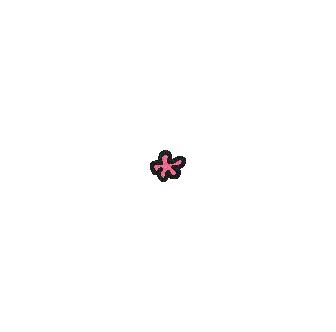




FOOD + DRINKS LOCAL ART SAT, OCT 1 @ 4PM MILWAUKEE RADIO LIVE MUSIC FROM YOU WIN !!!, KIA RAP PRINCESS + GEGO Y NONY ADVERTISEMENT

2 CONTENTS ABOUT OUR FEATURED COVER ARTIST REGGIE BAYLOR CREATIVE PROFESSIONAL FOLLOW @REGINALDBAYLORSTUDIO READ MORE ABOUT HIM ON PAGE 17 03 05 07 11 17 29 40 49 51 growing from the editor issue 20: homage ex fabula feature | a conversation with dasha kelly hamilton redefining vitality with element more choices | a homage to reggie baylor creating a path w/ mutope johnson beyond style w/ jeff mcalister pass the baton, this is bigger than you making fashion sense
EDITOR-IN-CHIEF / LEXI S. BRUNSON CREATIVE DIRECTOR / VATO VERGARA CHIEF OF STAFF / TIFFANY BEAN
FASHION EDITOR / KYNDAL J JOURNALIST / CARRIE NONI MAHONE JOURNALIST / IMANI ORTIZ INTERN JOURNALIST / NAOMI REA’
& WE COULDN’T
PAM WILLIAMS TANASIA SHAW EX FABULA DASHA KELLY ALEA MCHATTEN ELEMENT EVEREST-BLANKS
JAMIE ROBARGE PHOTOG RAPHY REGGIE BAYLOR
MELISSA COURTNEY WANYAH LEON WOLF STUDIOS MUTÒPE JOHNSON JEFF MCALISTER
FASHIONSENSE
FAVOUR RAY WILLIAMS JULIA PAPALLION
ANTHONY ANDERSON 8X10 PHOTOGRAPHY
SHALISA ELIZABETH LYNNHAIR DEBORAH RENDER
DEION HARRIS CHRISTOPHER BURTON
THOMAS MILLER DREWZKIEXPOSURE
CHARLES TRE’MALLE MCCOY KAMERON SYKES
EGZON SULEJMANI MANIELE FOWLKES-BANKS
PRESS PLAY PURDYWEAR RAKIM WIL MARC PATRICK ALEXANDRIA POOLE ZASHARY TORRES
JEZZRIAH BURTON DEION HARRIS SKYLA RICE DEANDRE KING EMIRE SEWELL ETHAN HIGHTIRE WALL STREET STOCK BAR DASMOND MCMILLAN ON WHAT STUDIOS
CONTRIBUTORS
MAKE THIS ISSUE POSSIBLE WITHOUT /
JORDAN CopyWrite Magazine Media & Design, LLC currently runs as a Milwaukee-based organization. All images are not licensed or owned by CopyWrite. For any questions regarding photos, future advertisements, future employment or any information about any featured artists, producers or creators, please contact us at copywrite.mke@gmail.com.
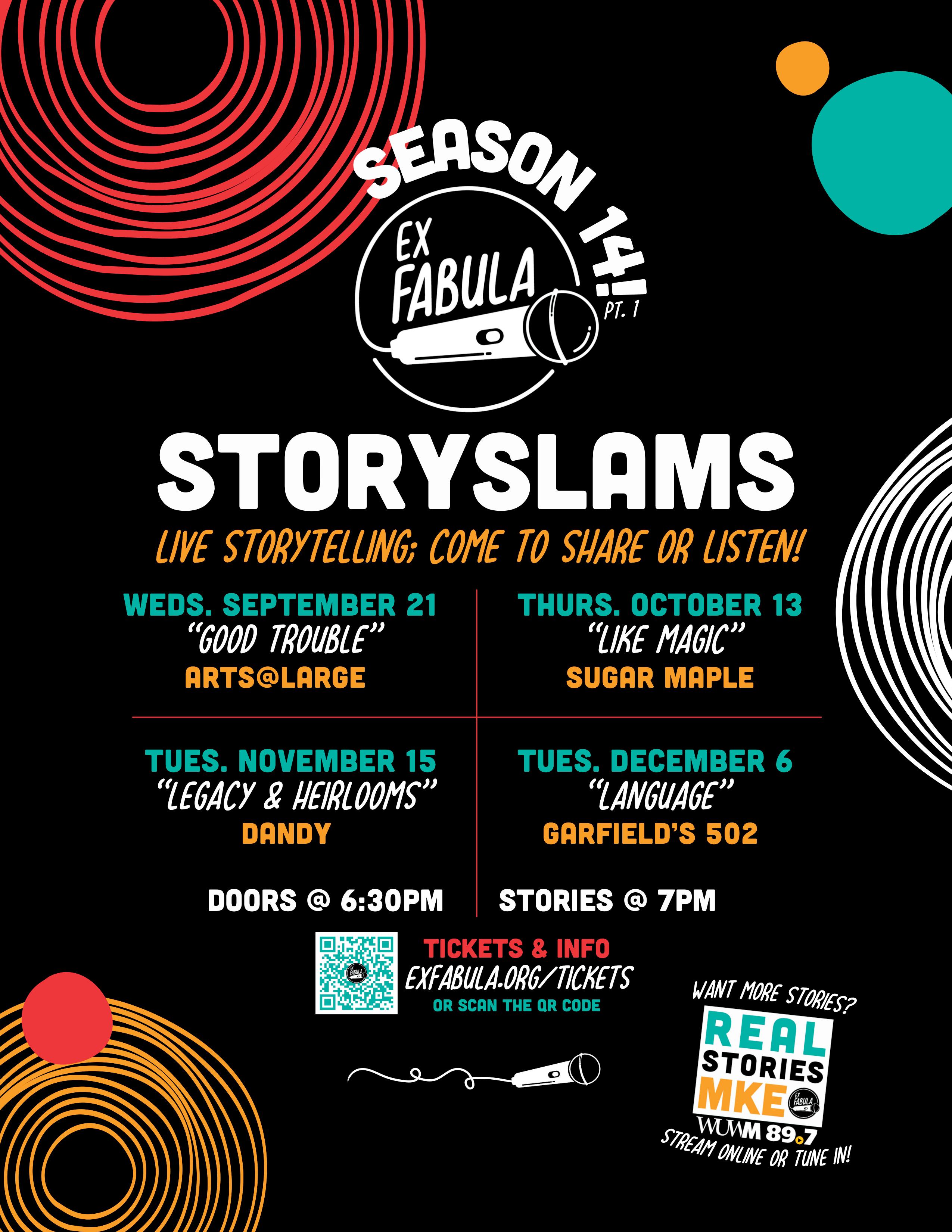
ADVERTISEMENT

@THRUDIRTYEYES
GROWING FROM THE EDITOR.
If I am walking through shaded pastures [or more like as I stroll through the canopy of the city], I must know that my placement in this type of existence [Black, Female, Educated, Professional Creative, Entrepreneur] is not by happenstance but by design. A design that came way before my arrival to this world. Before I could fix my lips to talk my sh*t about society and its inequalities. Before I could posture on any doubters that have, are, or may undermine or underestimate our progress. Before I could challenge anyone who has tried to disprove our truths. They gave me an opportunity to grow.
“They” are those who have come before us. Our ancestors, our elders, our OG’s, and all of those who have helped pave the way for me to be here, a chance, to be here. In this space. At this time. With this opportunity.
Those seeds of opportunity are ones that I feel don’t get acknowledged enough. We talk about giving people their flowers while they are still here but just think about the trees they have planted. The ones that have helped us break down segregation [We are not done yet]. The ones who have fought for gender equality [Pipe up, We Are Not Done Yet]. The ones who refused to cross the picket line because we all deserve a livable
wage [Ching! Ching! Say it with me. WE ARE NOT DONE YET]. But they started something that “once upon a reality” seemed impossible. With the little to nothing, many of them have had, they have nurtured dreams and futures.
Now I’ll keep it a stack. There are several who have dug their tunnels out and have let the dirt cave-in behind them. Even though anti-cultivation has been a guide on what NOT to do & that’s a blessing.
As I pay homage to those who have come before me [in media, art, design, poetry, higher education, etc.] I honor their survival, ingenuity, and wisdom. I take on their legacies as sacred obligations, that will need a [currently] vivacious mind to tend to them. I volunteer myself in this urban orchard to help plant new seeds of success, listening to how you till the soil, but also bringing in new ways to keep us together. [Let’s call it my retaining wall].
Thank you for planting trees. Now. . . back to work.
/Lexi
4 ISSUE 20
LETTER FROM THE EDITOR

REGGIE BAYLOR
Take this as a tribute.
An acknowledgement of existence. [#WeSeeYou]

A recognition of contribution.
A sign of respect and admiration.
In this Issue of CopyWrite Magazine, we take a strategic exploration of legacy. Noting the people, organizations, and cultural convergers that came before us. This, and all other publications we have released, are archives that WE exist and will not be forgotten in the folds of history. We understand that without the headway our predecessors have made, we would not be here. We also understand that history is only archived if someone deems it worthy and the narrative is always guided by the perspectives left “on wax”.

As we stand thankful for the inspiration and innovation that has been placed before us, we also ask for continued guidance as we take on the problems of the past, the obstacles of the present, and the unknown of the future.
How will you be remembered?
6
INTRO

DASHA KELLY HAMILTON, IN HER OWN WORDS, IS A WRITER, PERFORMANCE ARTIST, CURATOR AND FACILITATOR; A CREATIVE CHANGE AGENT, LEVERAGING THE CREATIVE PROCESS TOWARD HUMAN AND SOCIAL WELLNESS.
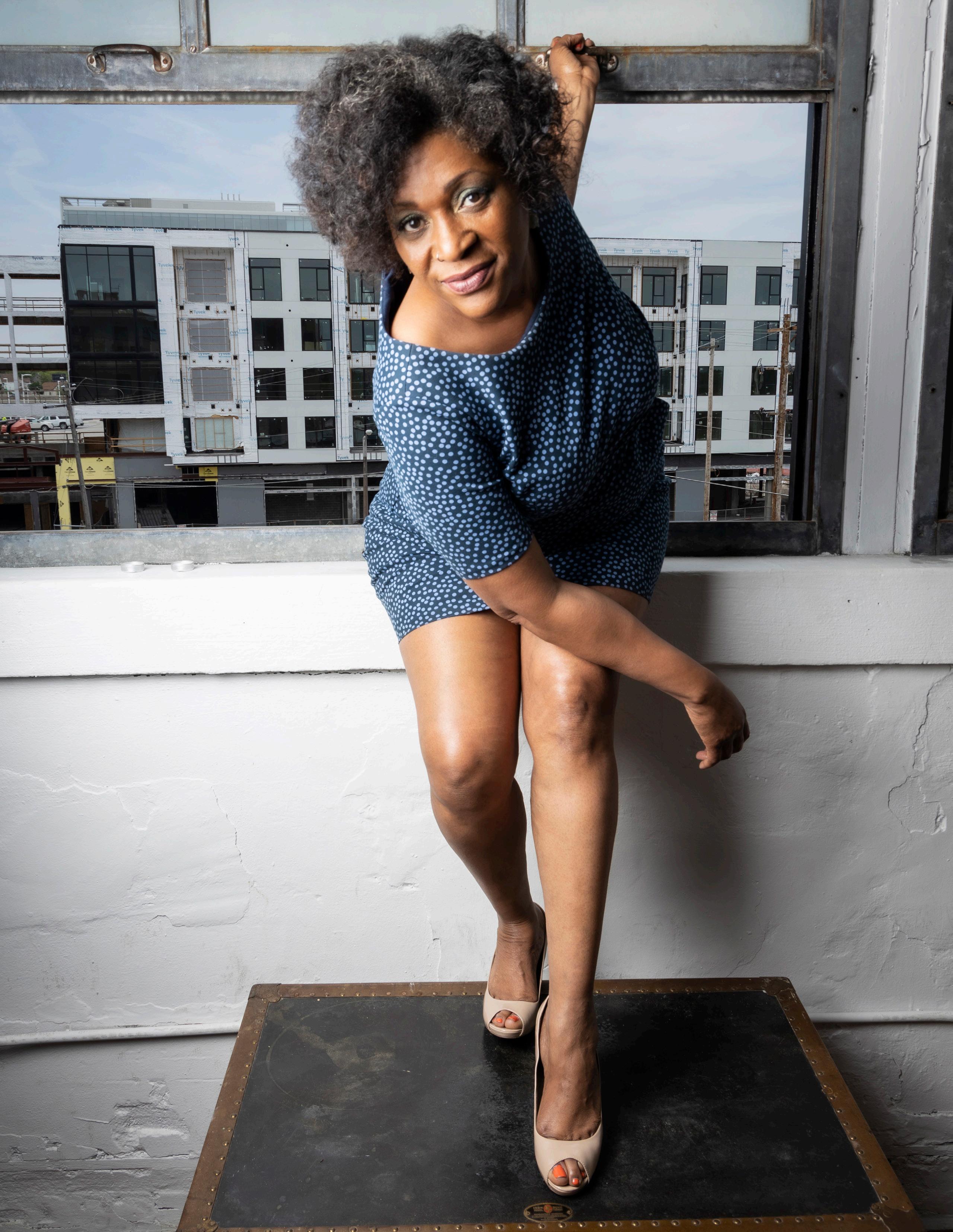
@DASHA_KELLHAM
.
DASHA: “My grandmother [Glorious Malone] was the first woman, and more particularly, the first Black woman to be certified by the USDA to be able to interstate sell meat, to have a sausage factory, and sell her product. And that’s kinda huge. Not that I didn’t know that, but I didn’t know that. To me, she was grandma. She got up, she drove into town, got into work early. . .and she worked all day.”
Over the years, Dasha watched her grandmother’s small store turn into a full-scale business. However, no matter how big and busy the business became, Mrs. Malone would take care of the neighborhood. At Mrs. Malone’s homegoing service, many neighbors shared stories of Mrs. Malone lending families credit for their groceries, acquiring their first job through Mrs. Malone, and more. .
DASHA: “I look back and see all of these imprints. This is grandma, and she does great stuff. She’s a great cook, and she’s kind, and she’ll tell you about yourself in a second, and [she makes] things happen. My mother, similarly, made [things] happen, gave us space to be creative and also, tell you about yourself. Working backward, [I’m] understanding the sacrifices, the work ethic, the tirelessness, the selflessness, but it’s just who she was. I’m grateful. Now, when I see how I work and why I work, and the way that I like to work with people– granted, we may have something we have to do together, or I have something that I need you to do, but we are people. I watched them treat everyone like people. I’m able to say that looking backwards, in terms of their accomplishments. In real time, I was always clear about how magical they have been. I thought my mother was a witch, but the good kind, like Glenda of the North.
. As a little girl, seeing candles and incense, and there are these special prayers that she did. I didn’t know what it was, but I knew that it was magical-special. And I knew that she was magical-special-- and [was] that without effort. We can think of people who try really hard to be kind; try really hard to show how golden their hearts are; try really hard to be, and I just got to watch them work through who they were and wanted to be, my mother especially.”
Dasha was a “sophomore year surprise” that called her mother to pause her collegiate career.
DASHA: “She stops college for this baby, then she finishes college when her baby is finishing college, too. I watched her give herself permission to take these different journeys to figure stuff out. One was watching her going back to school. My mother and I graduated from college within a year of each other. My favorite story, though, is watching her evolution as a healer, as a body worker.”
Dasha is a self-proclaimed “army brat.” While in high school, her family lived in Germany. To stay fit and active, Dasha’s mother, Daphne Malone, takes up Jazzercise.
DASHA: “She’s got her t-shirt and her shorts, tennis shoes; she’s hitting it. By the time I graduated high school, it’s gone to leotards and tights and the legwarmers, and tennis shoes, and she’s getting it. By the time I graduate from college, it’s colored dental floss - a thong, with matching sweatbands and legwarmers. When I’m out of college, she’s teaching a step class in the morning, one at lunch, two classes in the evening, and classes on weekends. She has a closet for her outfits - all sexy, little leotard-thongy-things on a hanger. She’s studying cranial massage, doing full body
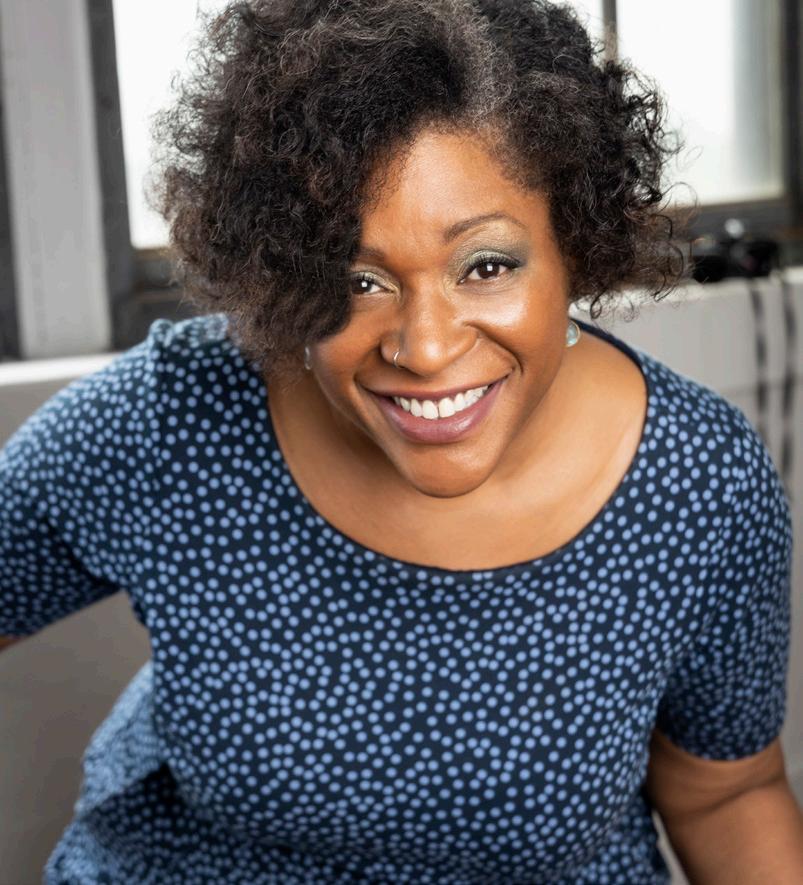
“I come from a long line of women who get sh*t done.”
EX FABULA FEATURE
massage. There are posters of the human anatomy cause she’s studying the muscle systems – to the point where, by the time I’m in graduate school, they’d moved and she’s doing Elite Massage at this fancy resort. And then, opens up her own business. At one point, I’m like ‘I’m sorry, did you say bartered for a fur coat? I’m doing this all wrong’. It wasn’t even that she knew where she was heading, she just knew she was going to study this and it opened up these other gateways. I watched her discover herself, as poetic as that sounds, but that’s what I was able to watch her do. Imagine your mother, who’s also a young officer’s wife, and she gave herself her life back. At that point, you’re giving so much to all these other entities around you. And my grandmother did the same thing. In all of those swirls, habits just appear. They just are how I am and I am my own person, too. I think I take a little bit of… relief. I was going to say pleasure, but I think relief is the word. To know that I am of that lineage, but I’m also distinctly me. My mother will look at me and go ‘man, you’re so familiar’, but also be like ‘who are you?’ That just says that the evolution thing is working. And that feeling of. . .of course, you’re not at all the parent . . .but having that “proud mama” feel for your mother. Watching. . . and it’s really interesting. I’m like ‘how do I. . .that’s not my child, that’s not my student, that’s my mother, but look at her’. You know? And my grandmother, when she moved to this building, I was like ‘look at what she did!’. I am glad [I’m] able to see my mother [and grandmother] as a whole person. That helps you appreciate them.”
Much like her mother and grandmother before her, to many Dasha has been a mentor, teacher, sister-friend, an inspiration and aspiration. To me, she is Mama Dasha – the woman who believed in my work, my craft, my power before I did. The woman to see the spark in all of us and call it forth.
TO STAY UP TO DATE WITH DASHA AND HER WORK, VISIT WWW.DASHAKELLY.COM

Ex Fabula is thrilled to partner with CopyWrite Magazine. This part nership will combine different forms of expression and produce a space for community members’ true, personal stories in written and visual form. By connecting the stage to the page, both Ex Fabula and CopyWrite will reach new audiences, connect with new storytellers, and build community.
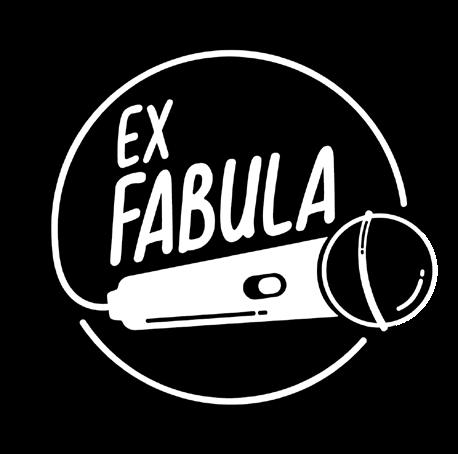
10
EX FABULA FEATURE
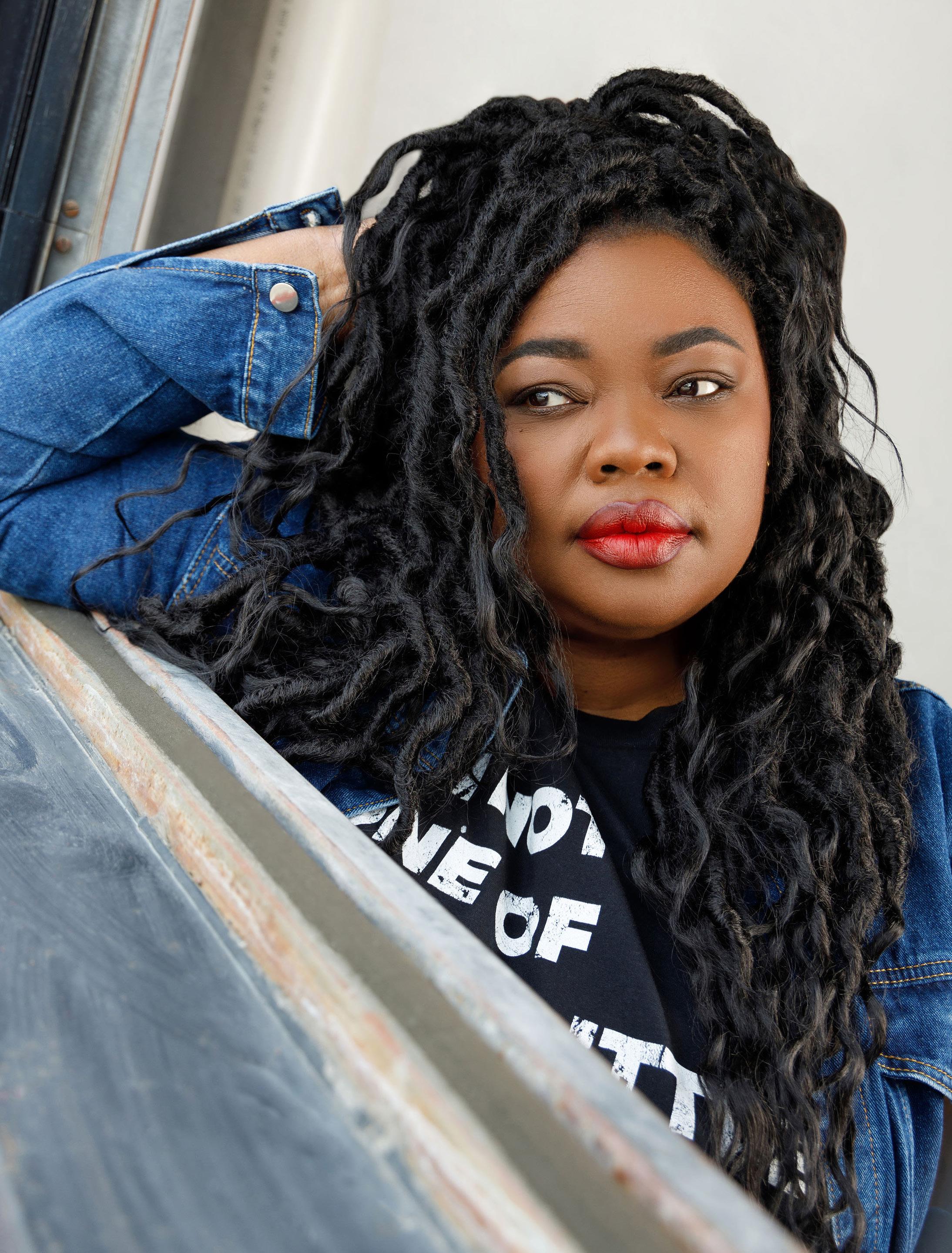
@ELEMENTEVERESTBLANKS
WITH ELEMENT
Vitality: noun

the state of being strong and active; energy. the power giving continuance of life, present in all living things.
It is a loaded and powerful term that we don’t necessarily think about on a daily basis. When something is considered vital to us, we look at it as a necessity. Within that necessity is a dependence on that one fixed thing or idea and without it, we don’t operate correctly. Oxygen is vital right? We can’t survive without it. We can’t see it but we know it surrounds us. It’s vital to our existence. It’s vital to our nature. No matter what background you’re from, your ethnicity, culture, or the like, we all need oxygen. Now. . . Let’s replace oxygen with space. I want you to go back a few sentences and replace the word ‘oxygen’ with the word ‘space’. Do you still feel that same necessity? Or Was that necessity lost in translation?
CopyWrite had the amazing opportunity to catch up with a Milwaukee mogul, Mrs. Element Everest-Blanks, who has been breaking barriers in the culture for decades. From being in a band, to being a solo artist, a Radio Milwaukee and Hyfin on-air host, a mother, a wife, and just a selfless Black woman overall. We are excited and honored to be a part of redefining vitality with Element; a different form of homage.
Imani: “Can you tell us a little about who you are and also who and what you represent?”
Element: “I am a Black Creative. I am a woman who is instinctively looking for ways to express the Black experience in a way that we can all understand, that represents us well and that tells our story–pushes the culture forward, just a little bit. Enough for, even people like my daughter to push the culture forward. That’s who I am… at my heart. I am a Black woman who loves Black people and ALL things Black. I am unshaken in my Blackness. And I understand that [that] can expand and I am okay
with that. And my Blackness will never look the same day to day. As you can see by my shirt, ‘Nerdy by Nature!’ I embrace all of my Black nerdiness and everything about me because I think that makes me a better person.”
The Detroit-native is no stranger to the musical and creative arts. As a child, Element was wherever the music was. Coming from a large musically inclined family with her mother being one of twelve, it wasn’t hard for her to find her creative niche.
“I was lip syncing to ‘Crush On You’ or maybe a Janet Jackson song and my family members would start to give me quarters. And I was like… ‘Wait a minute! I can make money from doing this?!’ It was really that simple.”
Whether she was reciting scenes from ‘Good Times’ or writing a rap over the latest instrumentals, she was constantly evolving and realizing, this is what she wanted to do for the rest of her life—and she’d get more quarters in the meantime.
Lexi: “At what age did you start being in a band and was ‘Black Elephant’ the first and only band that you were in?”
Element: “No! So I was in a band in high school, it was a singing group. . . And two of the group members ended up signing with Sisqo and became a part of his group, ‘Lover’. So we were trying to get attention by performing all over and we even moved to LA. [I was] even talking a little bit last night about how when we moved [there], that these two producers sitting in front of us, playing these space sounds to a hip-hop beat would hone their style and become Chad and Pharrell [of The Neptunes]. We were brought there by this guy who was a member of a group that Donell Jones was in. The group didn’t last but he had an eye for talent.
Element had many encounters like this including meeting Ne-Yo randomly at a studio who she recalls having an androgynous look and who’s name was so “Matrix” like that he wasnt going to make it in the biz.
Element: “I thought he was never going to make it. WRONG! Right? There was so much that happened in LA. We were
12 MUSIC + MEDIA
working with Dreamworks who ended up signing ‘Floetry’. It was one of those situations where it’s like you’re *almost* famous?
And you’re like, ‘Well, what do I need to do?’ Because Pharrell and Chad ended up going big and for me it was like, literally everyone around me–‘Lover’ ended up signing with Sisqo. Pharrell ended up being ‘N.E.R.D’ (Nerd), Ne-Yo went on to be Ne-Yo, you know.
And for me, I was like, what is it? Like every time we went and presented ourselves as a group, it was always MY look. It was my lips. It was my hair, my skin. It was everything about me being Black being the concern, not the problem! It was never my talent.
It was the concern, ‘How can we market that? Will people relate to her?’. I came back home and I was so broken. I was like I’m done.”
As unfortunate that experience had been, it would become the catalyst for a bigger change in her life. A change that today she can now note as worth it all.
Element: “At the time I was in a relationship with this guy. We got into an argument so my friend was like, ‘Come with me to this photo shoot!’ So I go to a photoshoot to support her and I see this guy. . . Everyone is walking around him and asking him questions. . . He’s about twenty and he’s putting together this CD and everybody who’s anybody is on it. Mind you, I know none of these people. I only know my friend. So I asked my friend, ‘Who is this guy?’. She says his name is Geraud and he’s producing, directing, recording, and doing everything for this CD for UWM Scope. . . and I should rap for him. I’m like, ‘Nah, I’m done with that.’ I go outside to catch a breather and he comes outside. . . He’s like ‘I don’t know you! Who are you?’ I’m like, “I’m here with my friend”.
Something convinced her to rap for him, and a good thing she did because he was impressed. Impressed enough to tell her to go back inside and take a photo because somehow she was going to be on the project and the logistics could fall into place later. Little did she know the logistics would include a marriage and kids with this “Guy” we now know as, Geraud Blanks, Element’s husband.
Element: “So I literally have a photo of the first day I met my husband. So that is my career story. About a year after that, he brought three of his favorite artists together for that project to do a song. . . We just kept making music and we became ‘Black Elephant’. It’s that simple.”
It was fate or some divine intervention that she had not broken into stardom in LA. The concerns about her image and how marketable she could be were industry cues for a larger narrative, we still are tussling with today. When we asked about some of her biggest challenges when starting her career and how she overcame them, she shared her perspective openly.
Element: “Early on, when I was a part of the group, I didn’t overcome it. It was a challenge. It was one of those things that was repeatedly hurtful. You know what I mean? When people look at you and say, “You’re not quite that’.”
While it was disheartening, Element had a strong support system back home that grounded her through every “no” and
every “not quite.” It would be only natural to have the thought to cut corners and just give in to the hype, but that support was crucial to her staying true to herself. We all are familiar with the propaganda of the music industry and how they tend to only push a certain type of woman. Element now believes that the industry will adjust to you. Once you bite the propaganda apple, you’re likely to lose touch with who you are as a person and forget why you even started that journey in the first place.
Element: “Back then, you liked people for their differences but now it’s like this universal look and it takes away from why you like artists. If everybody looks and sounds the same, what’s the difference?”
What is the difference?

Lexi: “So obviously, it ended up not mattering for the trajectory of your career for a period of time. You actually found a lot of success in that space. So how did you cross over to being in that space, being successful, and marketable?”
Element: “I think when I met my husband, I was in a place of self-discovery of who I wanted to be. That whole music industry thing was washed for me. I didn’t even really want to take that route again because when you work so hard to get up to a point and someone is like ‘Yeah, your toes are not going to work.’ Like really? . . . So at that point, I was really in a place of trying to figure out what makes me happy as a person and music kept coming back. So when I did the song with Black Elephant, I realized I really do want this. I really do like the group aspect of it and there’s some comfort knowing you can be yourself within that space and that they have your back. It became something I was really enjoying so I just said, you know what? Let’s just let this play out and see how it works.” Eventually the group “grew up and grew out”. Derrick ended up becoming a professor. Damian ended up having another daughter [which took more of his time]. The band again took shape with new members and became what is now known as ‘Cigarette Break’.
Element: “Everybody was growing in different ways but I still wanted to do music so then I decided to put my solo project out. After that, I got pregnant and that for me was like, ‘Oh my gosh, there’s a whole different journey I could be on. It’s totally different and totally foreign and it pulled me out of the music industry. I was literally in the process of recording my sophomore album while I was pregnant and I was in the booth and I just said stop. My husband was like ‘What’s wrong?’ I said, no… I just need to be pregnant right now. And I came out and he was like ‘Okay, let’s go.’ Sometimes in life when you think you want something, you’re in the midst of great joy, something else can happen. Then you’re like, ‘Woah, there’s a top floor to this?’. That’s what it was like when I was becoming a parent. I wanted to experience this new journey untouched. Just like I got to experience my music career up til that point, nobody stopped me and put their wants and needs on me. I got a chance to experience what it was like to go from an unknown in Milwaukee to presenting in front of
these label executives. That was my experience. I wanted that untouched experience as a parent too and that’s what I got.”
Balancing being a full time creative and a full time mom could be scary to some folks. Element takes the backseat when it comes to being creative at home, she’s 100% mom. While her daughter does have a lot of social media success with over 50,000 subscribers, Element likes to stay behind the camera and support in other ways while her daughter walks her own path to success. And If she does bring out her creativity at home, it’s only to help amplify her family.
“At work, I get to be Element—which is why I wanted to go back to Radio Milwaukee. I get to be an artist, I get to be who I naturally am but at home, I love being Mom. I don’t want those two things to clash ever.”
Being immersed in media is not for everybody and we understand that—so does Element. From being an active artist and transitioning into spaces where she now holds the cards for what and who’s next, she reflects on her experience as an advocate of local music. Not only does she think working for Radio Milwaukee/Hyfin is one of the best decisions she’s made, but she gets to find and support those artists who don’t get as much support because they’re not the “popular artist”. It’s important to realize that there are hundreds of other artists who live, breathe, and eat Milwaukee music all day, every day. They are just simply not as popular or don’t know how to market themselves—which is where Element comes in. She’s the host that’s telling you the full critique in a supportive manner and will let you know, once you fix this, you’re on-air.
Element: “People can use me to advance their careers and that’s a really good feeling. I’m not one of those people who’s going to try to sit on the throne and hold back and make you worship my past. I’m not doing that because I had to go up against that. You need people who have had that negative experience to make sure when they get in that position to support people, they actually… do it.”
Lexi: “I think that’s really important because a lot of times, as much as we want to pay homage, we also want to see the reflection. Like the work that you guys do matters and we want the opportunity to push the next generation ahead. I think that sometimes there is a feeling that the younger generation who’s actively trying to source out their career is not getting enough support from the people before us. Then sometimes there’s a question, Is it because we’re not good enough or is it because nobody supported you and you’re like you better do it because I had to find my way?—”
Element: “Honestly. . . if you have a family of eleven aunts and uncles and all your thirty-seven cousins are sitting around clapping for you and you know those people genuinely love you and even though you’re five years old, you know when somebody
is championing you. They don’t want anything from you. They just want to see you succeed. . . and they gon’ give you a quarter? I think a lot of our previous generations did us a disservice in a lot of different ways—being Black people. They kept the jewels and the messages to themselves and they just kind of passed us off as, ‘Oh, they into that hippity-hop’, and then they downplayed our contribution. We all know that the youth has the energy but the elders have the wisdom. So if I’m becoming an elder and I have the wisdom and I know how to navigate this industry, I’m not holding that to myself because I’m not gon’ be here forever. . . I get paid to support artists, talk about and play music all day. It’s not really even a job for me. Why would you keep that to yourself? Why would you want to make people bow down to you to try to get their music played? That’s not even me. It’s just not.” And it’s not just talk. Element actively uses her platform to help others, even more recently she has been using her social media to highlight local events, business, and more with her #BlackFriday reels.
Imani: “So we’re going to take another pivot… What is something you’re secretly good at outside of your career?”
Element: “I have 50 Rubix cubes and I can solve every last one of them.”
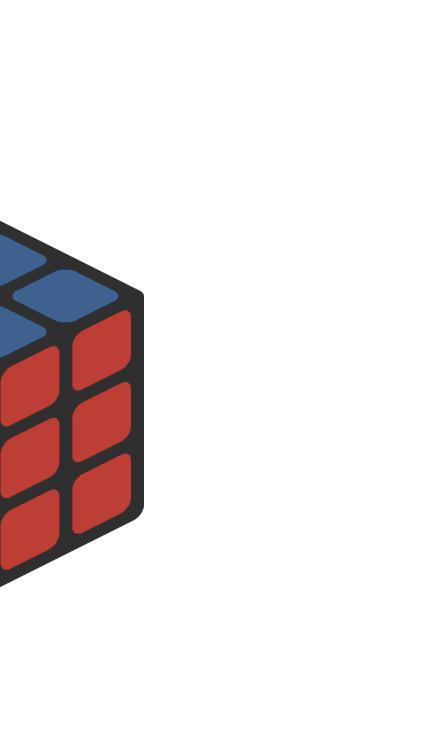
Imani: “Wow… that was not what I was expecting.”
Element: [Points to shirt] “Nerdy by Nature! I think certain people are built to be attracted to certain things. Color, texture, I also have this thing called synesthesia. I don’t know if you guys have ever heard of that. It’s when your senses in your brain—think of your brain as highways, right? And sometimes those highways touch just a little and that little bit of touching can cross over your senses. So for me, certain letters like the “i” in CopyWrite [referring to the logo on our /CW backdrop] it has like a little halo on it. It’s 3D for me but the black one in “magazine” is not. I can also taste certain colors because they kind of intersect and I think I’m just attracted to certain things that play on synesthesia. Now, if you have [that], you don’t necessarily know that other people’s brains don’t do that because you think that it’s normal. I think that a lot of artists have either autism or some kind of brain chemical that makes them auditorily different. Especially with writers, you guys are so observant. When people talk, some of the subtleties of how people move and their eye movements and things like that, [you] notice but the average person doesn’t.”
CW: (In unison followed by laughter) “Absolutely!”
Imani: “What do you think about the current state of music/radio in Milwaukee? Or maybe even in comparison to 2007 when you started?”
Element: “I think back then, there was less support of local artists. And just like everything else, people have their favorite artists that they want to support. I think now, that’s changing because artists can put their stuff out, create a buzz, stations have to come

14 MUSIC + MEDIA
in calling—which is how I hear about those people. I think the opportunity to get more out there is better now and I think we’ve laid some track work. For Summerfest shows, Jazz in the Park, all of these places where people get to display their art, we were kind of closed off back then. I think because of the transitions—the world shaking with Trayvon [Martin], with George Floyd, with Ahmaud Arbery, I think these organizations and businesses have opened up. They’ve hired people to make sure that they’re not as exclusive as they once were. A lot of the Black and Brown people at these organizations are doing their best within the confines of their job and changing the cultures so we’re getting more opportunity. It’s a beautiful thing. And, you don’t have to wait for a label to distribute your work anymore. You can just go straight to spotify and post your own sh*t—which is beautiful because artists aren’t beheld to anybody anymore. If we would’ve had that as three girls and somebody denied one of us, ‘your look isn’t fitting. . .’, we would’ve been like ‘Alright, bye!’. I’ll just become Meg thee Stallion on my own, you know what I mean? And that’s what people are doing. The sound is drastically different but back then, they were talking about how Tupac and Biggie was gon’ ruin the world. And how NWA was like— ‘oh, everybodies gonna die!’. So for every generation, the sound is going to evolve, change and represent that generation.”
The word of the day is, “space.” Space is vital to our community as creatives.
“We all need space to change our sound, to evolve when we’re beyond where we once were. I think we need space to be able to be 100% authentically us.”
Element emphasized that we tend to be confined in spaces that we walk into and we don’t have the same freedoms to be able to express ourselves to the fullest degree free of judgment. We need space and spaces to let our hair down and just be who we are sometimes. Let’s peel back all the egos, all the stereotypes, all the wild societal standards that only *some* of us are held to. It’s time to let it go and let there be space for magic to happen. It’s time that we have a space that we can actually be free in.
Imani: “Why do you think it’s important for us, in the culture, to pay attention to those who came before us?”
Element: “There’s so many reasons. If you don’t have a visual representation of where you can be when you’ve made it through, how do you know you can make it through? And some of those people didn’t because they
couldn’t see it or they couldn’t pass it. They couldn’t see past that anger that they were feeling when they were being constantly disrespected and they put them in situations to lose their lives, they couldn’t see it. So paying homage to me is important because it lets us know what our past is and what our future can be.”
Lexi: “The last thing I want to add is. . . it’s not over for you. You’re still in a space where you can create whatever it is that you want to create and take it wherever you want to take it. As you’re moving in this space… driving, driving, driving, is there something that you are trying to have in front of you? Is there something you’re driving towards? Is there some other thing that you’re trying to do?”
Element: “Yes. There’s something really simple that I want to do. I want to create a t-shirt line. If you know me and you go to my instagram— I love a good t-shirt, okay baby? And since I’m putting it out there, it’s intellectual property now! I want to create a line called “M.M.W.” (My Mama’s Words). Something like ‘I’m not one of your little friends!’ Or ‘You think fat meat ain’t greasy!’. Because when we walk down the street and we see each other, we’re like ‘Where did you get that shirt?’. And all the lessons my mother has taught me, I find myself saying those things to my daughter and son. It’s literally a universal record. These are life lessons that we’re repeating and don’t even realize it. So I want to create that, “My Mama’s Words.”
Imani: “That’s a great idea because obviously, if my mama says that, I’m going to buy it! That’s exciting.”

Element: “I’m excited about this issue. The reason I’m excited is because I know there’s going to be people in here that I’m like, ‘Yes! Yes! Yes! That person needs to be acknowledged. That person has done so much for the community, so much for the culture, so much for the city.’ They’ve laid the groundwork for other people and they need to be acknowledged. I’m excited to see who else is in this issue. I’m genuinely excited.”
So whether you are new here or not, Element is the one you want to have a conversation with regardless of local social status. It’s gravely vital that [we] as creatives find our space in spaces that want us to be there—not ones trying to meet a quota. Why beg for an apple when you can get a feast?
/Imani for CW
MUSIC + MEDIA
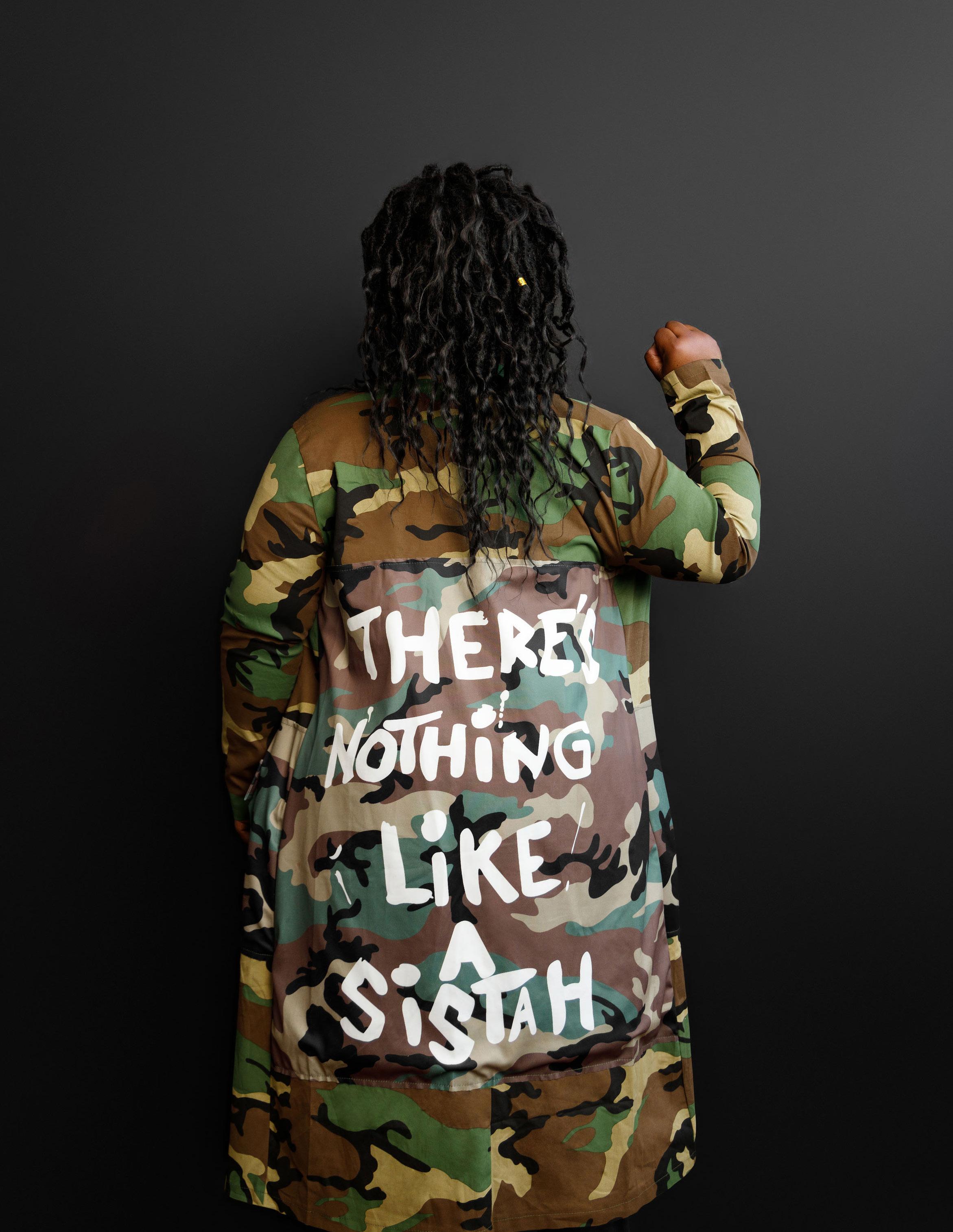

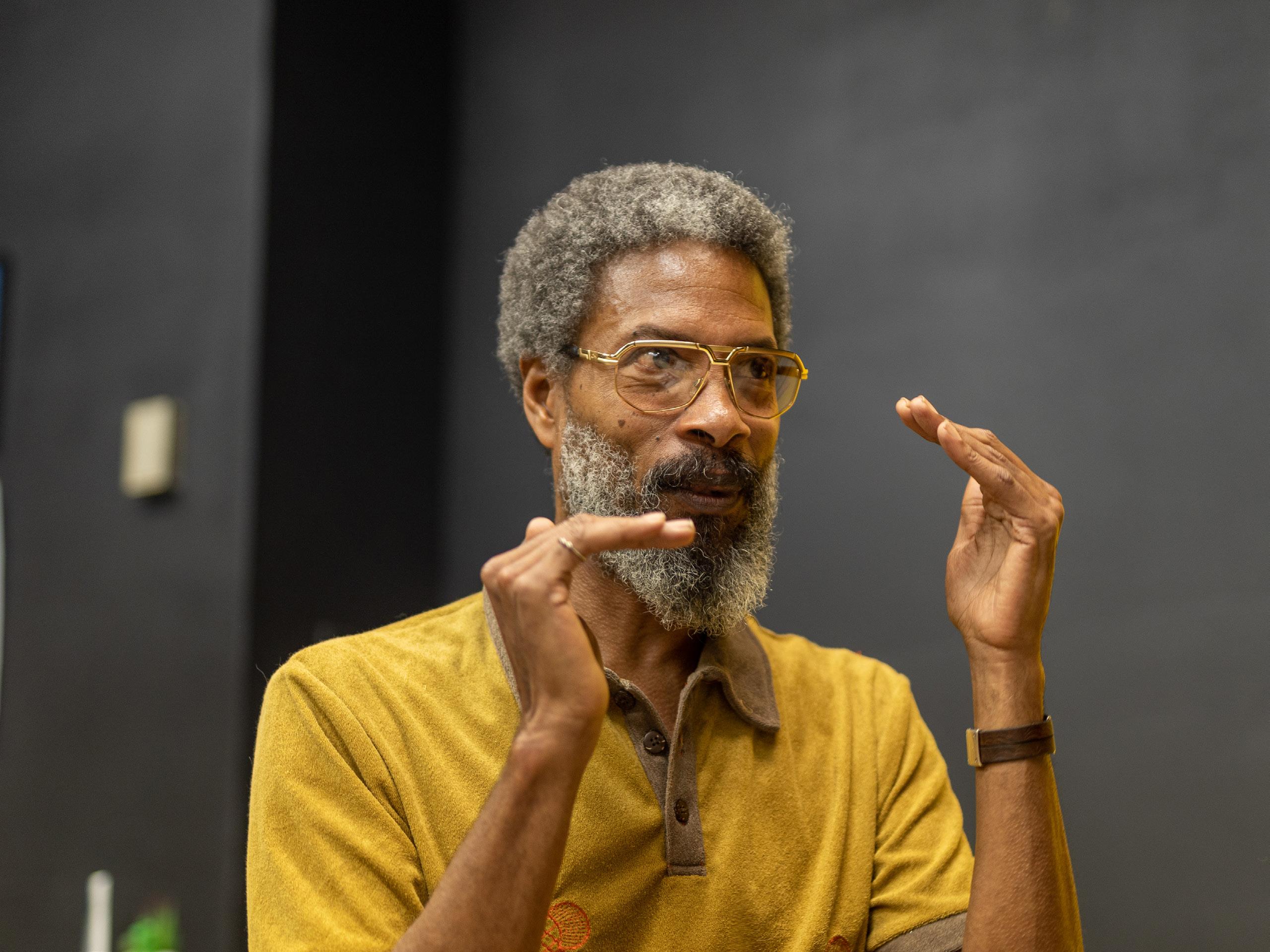
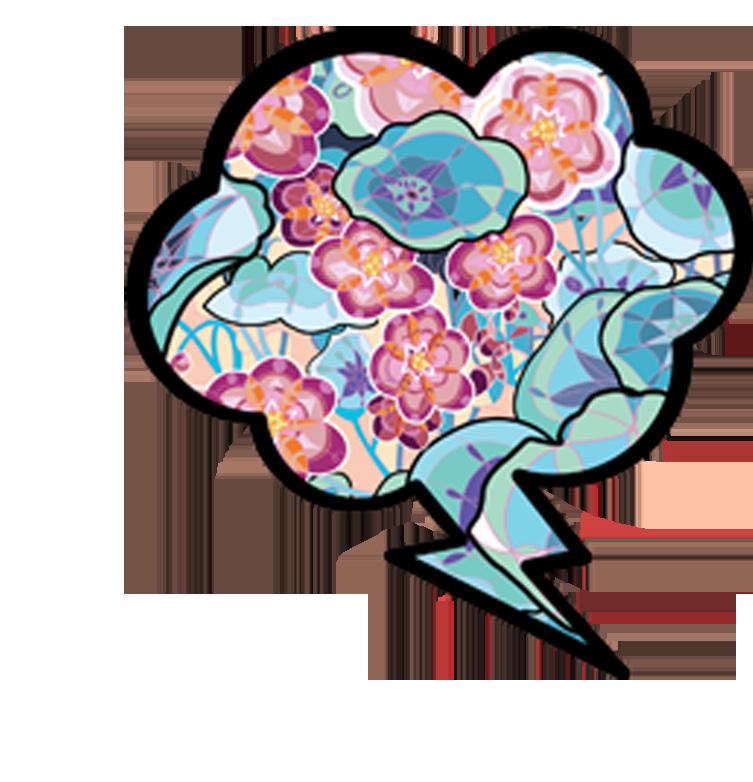

@REGINALDBAYLORSTUDIO
Reggie Baylor is a Creative Professional.

Not just an artist but a multifaceted creator who is constantly thinking about ways to engage with the visual world, culture, and industry.

His work is beyond distinguishable. The crisp clean lines, the enthralling color use, the imagery that feels familiar but yet applied via unorthodox design. It’s graphic. It’s bold. It’s. . . So many things that no list of grandiose vocabulary can pin down as just “that”.
His creative choices have always been a point of reference in the dialogue of major players in our city. Thus, to pay homage to his career is an opportunity to immerse ourselves in the knowledge that you can’t receive by reading an artist’s statement or having a quick chat with him at a festival. Unbeknownst to us, we would find out that Reggie’s path to success is a cultural narrative that breaks rules, defies systemic boundaries, and plays one hell of a game of logistical strategy. Reggie joined CopyWrite for a special chat at /CW HQ to fill us in on it all.

ART + DESIGN
CW: “How did you come up with that style of art?”
RB: “I would say that it is a product of what I enjoyed visually from childhood to being an adult. Quite a few artists or painters that I admired tend to have more graphic presentations to it. Looking back I recollect loving cereal boxes and going to grocery stores and seeing Hallmark cards, or watching TV and seeing cartoons. I always had a fascination with logos. Logos are stylistically brilliant. Take one icon and communicate a whole narrative to a community.”
His piece, On Duty, Not Driving, which lives in the Milwaukee Art Museum’s permanent collection is a direct reflection of that progressing adoration of industry where design and art become entangled. But it is not an anomaly. Reggie’s “style” comes with anecdotal gold. It is a legacy of creativity not controlled by one medium but by several ways of expression. It is not just what you see before your but the life that had to be lived in order to create a visual narrative that carries Fine Arts prestige tangibly meets High Design.
[& you know, we love a tangible narrative]
Reggie’s story is filled with transitions. Bold choices, rather self-selected or by obligatory proximity, have made his life a breeding ground for diverse experiences. Experiences that have not only shaped who is today but gave him insight into the possibilities of who he could become. From 14th & Keefe to 41st & Hampton, right out to the suburbs, his world would be forever changed.
RB: “I am a city boy by nature. Moving to the suburbs was not ideally my first choice.”
His parents had bought a lot in Mequon, WI in 1966, the year Reggie was born. Both of them growing up on farms, they thought raising their kids out in the country would be best. They decided to get jobs and get settled in before they would go live on their more rural land.
RB: “They wanted to countrify [their] kids.” [He laughed as though he now admired the idea, which middle schoolaged Reggie was not too fond of.] “Fortunately the school I wound up going to had three full-time art teachers. Obviously, because there were so many things there that were foreign to me I really gravitated towards the art room.”
Art was his thing. It was his sport, his hobby, and the only classes he was actually getting A’s in. It was his comfort and his freedom. It was a way to make sense of what was.
When Reggie decided to make Art his field
of study after graduating from High school and attending the University of Oshkosh, the choice had been fueled by the Pop Art Movement.
RB: “It was culturally relevant. It was graphic. It was Keith Haring and Basquiat doing stuff on the streets. It aligned with Hip Hop music and fashion. It didn’t present itself the same way as old traditional artists and art movements we studied and heard stories about. . .It’s the story that became more interesting than the product. The culture became more interesting than the art.”
CW: “How did that translate in Oshkosh?”
[If you’re not a Wisconsinite, you might want to go ahead and get your maps out. Smacked dab in the North-Eastern region of the state, there’s a little college town off of Lake Winnebago. That’s it. With all the stereotypical understanding of what that place may feel like, imagine. That’s where he was.]
RB: “MTV. It was MTV. All the dorms had cable and at that time everyone watched MTV. That was a cultural sh*t show, if I may say. It was the beginning of MTV. More graphics. It was the beginning of new technology. More access. It was the first time other than staring at an album cover when listening to music that there was a visual to go with the song. And I loved that a lot of the time the visuals had nothing to do with the song. So I was like ‘Okay, isn’t this abstract expressionism?’. This was moving faster than the history book I paid for. So that just moved into, ‘Okay, what would a Pop artist do?’.”
What would they do?
As Reggie discussed the nostalgia of MTV’s unprecedented contribution to visual language. We tried to unpack our understanding of the phenomena in its infancy. MTV had broken the mold of “appropriateness” that had kept art forms of different mediums, motifs, and makers in their respective corners. Here, it was as close to free rage as the time would allow. We would argue that urbanism had finally decided to burst the status quo bubble.
RB: “That was a time when tagging was ugly and now tagging is an international cultural language. It emulates the exact [type of] process in which people thought [tagging] was primitive, hideous, destructive, and of no value. On MTV there were tags everywhere. Then it’s like ‘Oh Okay. We’ll see.” [He said facetiously, as we already know how big of a success MTV has become]. But as much of the anarchy [or what is now historically known as Pop Culture] Reggie was fascinated by, he still moved strategically. He had chosen to move into the field of education to combat the starving artist fallacy. It was a move for stability, a path to creative community, and
ART + DESIGN

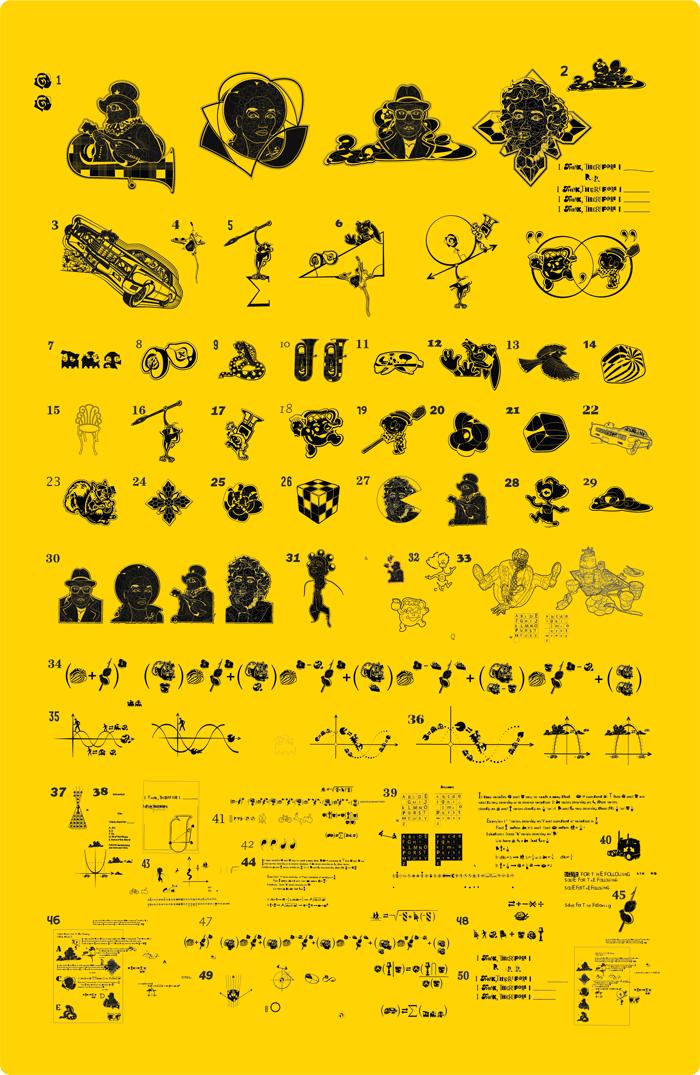
an opportunity to teach the things he enjoyed like Hip Hop. But the logical option is not always the answer.
RB: “Student teaching felt forced. . . And it somewhat has a little guilt to it because I appreciated all the teachers that had gotten me to that point. I thought that I could just honor that system and be a part of that. I thought I could use that gratitude to be of service to somebody else. But you’re right. There just felt like there could be another way of doing it.
So he did. . .
But here is the part that we were not prepared for. The pieces of the story you can’t find in any bio, or from an excessive search through the internet for “the goods”, most commonly referenced as pre-interview research.
RB: “After student teaching, realizing I was going to have a Fine Arts degree, and MTV; Those things were battling so that’s when I dropped out of school. I actually didn’t graduate. I opened a nightclub.”
Yup, that’s right. A nightclub called Dalmatian’s, named after the Black and white partnership between Reggie, his brother, and a white DJ.
RB: “Three or four of us used to go down to Waukegan, Illinois with a boombox and we would record the Chicago House music. We would take the tapes back up to Oshkosh, we would rent halls and
throw dance parties while playing those tapes.”
CW: “They were a hit weren’t they?”
RB: “They were! I mean it was Oshkosh and there was a certain student body of people from all over and particularly people of color who were in on this music and there was nowhere to find it there. Doing those events made us think that maybe we should do them for profit. So that’s how that started”

The black and white representative icon Reggie made for the Dalmatians was a cultural statement of what was possible when you bring people from diverse walks of life together.
CW: “So even then while doing the music you were still using your art connecting visual language to talk about culture.”
RB: “Yea, because none of those people would go to an art show. But they’d go to that dance hall. So again it is how do you bring both of those together and take them all forward?” Still, Reggie was young. He was 21 years old, with a shelf full of liquor, music always going, and a club.
RB: “It went how it is probably suspected to go.” [We all laughed, thinking about that age with those types of resources].
When Dalmatians ended Reggie packed up his bags and moved to California. The woman that he had fallen
22
in love with in college had already moved to The Golden State, so he decided to chase her. The chase wasn’t a difficult choice considering California was the place to be for an artist with lots of new opportunities to dabble in.
CW: “California is quite different from Oshkosh. Was that a culture shock for you?”
RB: “A very welcoming one. It was very exploratory. Post college? Talk about a learning experience. It was a whole ‘nother classroom the way I see it. For what I did professionally and what I did artistically. But that’s also when I started to be employed in the industry. I wound up working at a couple of galleries and two museums.”
He noted that both the gallery and the museums juxtaposed each other. He was now confronted with the traditional Museum setting, whereas the galleries did not sell what would have been considered museum-quality work. But the galleries allowed him to communicate and network with other artists; He had access. However, the museums also had their perks, where he could touch and hang the art from all the artists he had been studying.
RB: “I liked the romance and elegance of the experience. I learned the importance of preservation. People couldn’t wait to come see these works and I got to touch them. I get goosebumps now just thinking about it. Here I am taking them out of these crates. It made me fall in love with the back of the work again [because you can see all the notes on the back of the work]. You can tell if the painter was uptight or loose. Something that could be worth a million dollars could still have screws sticking out of it. . .”
As artists, we know that those moments tell the story the viewer does not often get to see. Those nuances are the reflection of process, practice, and perception. They are intimate and exclusive. Those moments hold value.
RB: “One of my other jobs was to go to private individuals and pick up the collections that they were offering to the museum for a show. That was fantastic because they are mostly wealthy people and the stuff that they have in their houses.” [He whispered as if in awe] “Like what are you guys doing? This is beautiful. Tuh, you want to buy one? I mean you’re not allowed to say that but I was always thinking it.”
CW: “It’s interesting that you say that. You’re talking about wealthy people, going into their houses, and seeing this amazing work. I am fascinated because I have gone into some wealthy homes and seen your work [Like right across from a Kieth Haring to be exact]. I’m always excited that I can point out, ‘Hey, that’s a Reggie Baylor’. You just have a recognizable style that I think should be referenced as iconic. From you being the admirer to being admired, and conversations are happening about
your art in those spaces, how does that make you feel?”
RB: “It feels great. It’s like a childhood dream. Being presented with those experiences that acknowledge the dream was rewarding. I’m grateful. It’s fantastic and I actually didn’t plan for it. I didn’t even put it together. I was really just responding to anything possible. If it had a positive vibe it was like okay I can at least go down that road. That has always been the beacon. So I just tried to follow that again, while learning and listening. But oddly enough it’s interesting that You say that because I don’t walk into rooms and say, ‘There goes a Reggie Baylor’. I’m like, ‘Oh there’s that. I mean I like it but ya know, I did that.”
Yes, he did!
But how? Professional artists, even the most talented, don’t just plop out of the sky where they are being showcased in spaces where big money is moving [& we mean BIG]. The California classroom of life had informed him of several noticeable choices or perspectives he could always keep with him:
• Culture: “The diversity was apparent more.”
• Class: “It was like existential class warfare in this land of chill, warmth, and vibe.”
• Access: “To creative experiences. Visual art, music, dance, theater, and everything else.”
• Art: “is a part of the culture. It’s a way of life. High Design was something to talk about and critique”
When Reggie moved back to Milwaukee from California it was a financial, personal, and family decision. With those priorities, Reggie moved out of working in the art sector into trucking. It was a moment to find financial sustainability, while still giving himself time to paint on the side. The least suspect path to becoming a successful artist became its forthright
RB: “It made sense and coming from a family of drivers it was familiar. There wasn’t a massive learning curve. I didn’t have to go to school to learn anything and I was able to have a balance of immediate revenue and making works and a lot of it. But before I left California I went to meet a dealer, picking up artwork for one of her collections, and we just started talking. So while I was here driving the truck I was sending paintings to California to be sold.”
The income he would make from selling a painting he would put back in to make more paintings. After a few years of doing it, he figured since his paintings were selling he should go ahead and sell paintings for a living instead. So while she kept the California market bustling he would start a Milwaukee market for his work.
The one thing that he had noticed about California that made itself more noticeable once jumping back into making was the architecture and general landscape of the state. Where
ART + DESIGN
Wisconsin and the Midwest are rich with architectural history even in the most impoverished sites, California had new construction that lacked the layered comfort of our visual allure.

RB: “I also know that when I came back to Milwaukee the first three paintings I did were of neighborhoods in Chicago. It was a direct result of leaving California and moving back to the Midwest and looking at the architecture. That is where I get the straight-edge love from architecture, which is also sculptural. Architecture is just an easier sculpture to sell.”
But in Milwaukee, the market is not as culturally attuned to art as one would hope. Finding that beat to success is a task that we are still trying to navigate. Reggie’s theory suggests we look a little deeper at the surface facing issues:
RB: “When I was driving a truck I listened to a lot of talk radio. The cities that I drove to the most were post-industrial cities like Buffalo, Philadelphia, St. Louis, Detroit, Chicago, etc. They all had the same narrative. Manufacturing is leaving. What are cities now and how do we grow our cities? At that time it was a conversation about the creative sector, what the creative economy is and how does it inspire culture, and how does it inspire a culture to rebuild. To rebuild requires creativity. This could be a great loop economically. So I was like, ‘Woah! The creative economy, what’s that?’. Because they didn’t say art gallery or museum. They said creative economy. Now I’m driving a truck. I understood the trucking economy. So this is a system. A system I can be a part of.” Milwaukee had already started to have this vital conversation about the creative sector thus its locality was a perfect place to interject himself. He would keep listening to the radio about this possible solution to new age urbanism, researching and applying the knowledge gained.
You can see these ideas in the work that Reggie is currently doing. Bring art to your everyday consumer so that it’s more than just the painting on your walls that depicts art. At the start of his own home goods store, at reginaldbaylorstudio. com you can find, “tailored home goods, pop art prints, vintage style prints, wall art, designer shower curtains”, and more.
RB: “Interesting enough the fine arts world is now using luxury home goods as a conversation about paintings. It makes sense because it’s something private owners can put in their homes. Then why don’t we have that conversation so that it’s expandable and everyone else can feel like this is a part of their home? Not that the gallery is not necessary but you know people have some preconceived notions about what a gallery experience is. In order to expand outside of that narrative, you have to redesign your mission. We sort of thought we were meeting in the middle there.”
With this method, Reggie has found a way to engage
24 ADVERTISEMENT
red change to green



 greens & the small machines
greens & the small machines
MILWAUKEE
with an audience at several levels allowing for the viewer to also become a consumer. It allows for a shift in the narrative that says art does not just sit on walls, it exists in other places like on streets, in clothes, or even in a grocery store on juice bottles.
CW: “How did you wind up creating the art that goes on the bottle for Juiced! Cold-Pressed Juicery?”
RB: “A person who admired my work, a collector, is a part of the Juiced! brand. In his research and his process of redesigning the label, he saw that many companies use artists. They wanted to keep a ‘We are from Milwaukee’ narrative with a Milwaukee artist so I was approached. So yea, that was a blast.”

It’s a smart move by the company, but also an important choice for Reggie as an artist. Where the branding now totes his creation, it also becomes another example of how art exists in everyday life. As you sip a refreshing drink you too can now say, ‘Hey, that’s a Reggie Baylor’. No museum admission or gallery browsing is needed.
Even so, there are constantly new factors that are coming into play. The creative economy is not stagnant and the technology beast creates new obstacles that can also become new opportunities.
RB: “Technology is a major driving factor on how we present concepts, how scalable a concept is, or accessible a concept is. Can we take the design and feed it through technology? That’s one point. Then we are always looking at expanding a product line. Then we look at a product line from a design point of view. That has also allowed us to switch in to a design firm. From that we can say
it’s not just art we produce, we produce products.”
The idea of producing a “product” even verbally seems more accessible, thus opening the conversation for the need for art. Reggie noted that Mellissa, Creative Editor of Reggie Baylor Studio, made a point when she told him that as an artist he always wants to talk about how great a shower feels but a plumber just makes sure you get water.
This realization and receiving the grant from the Joyce Foundation to do quality community artwork were major advancements in Reggie’s thinking and current career. The collaborative component now pulls him. What can you make with collaboration? How can the concept facilitate community? What more can be developed from this partnership?
If collaboration moves the needle of progress and creative problem solving fuels the ignition then how does Milwaukee take harness of its goal to be a place for Arts & Culture like other cities that have prospered in the last few decades?
RB: “Those cities that we are talking about really gravitated towards the creative sector to make their identities. They share that narrative like a song to the rest of the nation to be attractive. Milwaukee now probably stands as the grittiest city. You could probably come up with a narrative and it will sound just like what the Bronx did. Where you would get majorly concerned if it got worse. We don’t want to take another downfall. Out of that is where we get that grit. There is only one way to go.”
And that’s up.
Reggie believes for us to take the next step to really address what the city could be there is a need for a lot of equity and inclusion. Not the buzz phrases corporate institutions throw out to avoid lawsuits but the real collective design for a movement.
CW: “Do you think as a full narrative, our infrastructure, our politics, our people in power, and all the things that go with it, do you think they’re stuck in this
26 ART + DESIGN
“We are on that plumbing side now and Milwaukee pipes are leaking. If you say arts and culture is the differentiator then you should call a plumber and trust that these parts work or not.”
post-industrial era trying to find an identity? Do you think that is the reason we are having a more difficult time and a longer time figuring out what a collective voice is?”
RB: “That’s a good question. I think the narrative is open. Its opportunity. I remember going to Nashville and my uber driver said just count the cranes. If you want to know what the city is up to, count the cranes. Those cranes are on some 50-year narrative. The prediction is that there are a lot of people coming back here. Do we spend 48 million dollars on this building here in Milwaukee? Yes, because this is growing, and this is growing, and this is growing. But where is all this growth? And what about the areas that are not growing that everyone is talking about? Then it’s like, ‘We will get to that. We’ll congregate and keep on discussing’.
That right there is the part that bothers us. The growth is happening fast but is it happening with and where it’s needed the most? Ask an artist and they will tell you.
Oh, Reggie, now you’re talking our language. It’s the art of collaboration that you need to make a building that is undeniable. If you think about the creative economy there are hundreds of reasons why we should start thinking crane over easels and together over apart. If we are going to thrive, we are going to need every definition of “space”.

As Reggie and his team continue to find collaborators to build with, he is also bringing his journey with him like an explorer who notes what he has encountered as new wealth of knowledge. It’s something that you always carry with you, even if you don’t quite know how you’re going to use it yet.
RB: “There are an infinite amount of paths that are available and open. So it can be really difficult to say, ‘Okay, if this happens then this is the path to take’. I can say that every opportunity I have had came about because I had a body of work. . . Some people may have had five works [of art], but I would have twenty. That doesn’t mean that those five were not excellent but now the person who is choosing has twenty to choose from. It’s similar to a resume. Do I like resumes? Ehhh. But are resumes relevant? Yes!”
& just like that, you have more.
More to show. More to sell. More to experience. More choices.
ART + DESIGN
“We are talking to the wrong people. We need to start figuring out how to get cranes.”
/CW
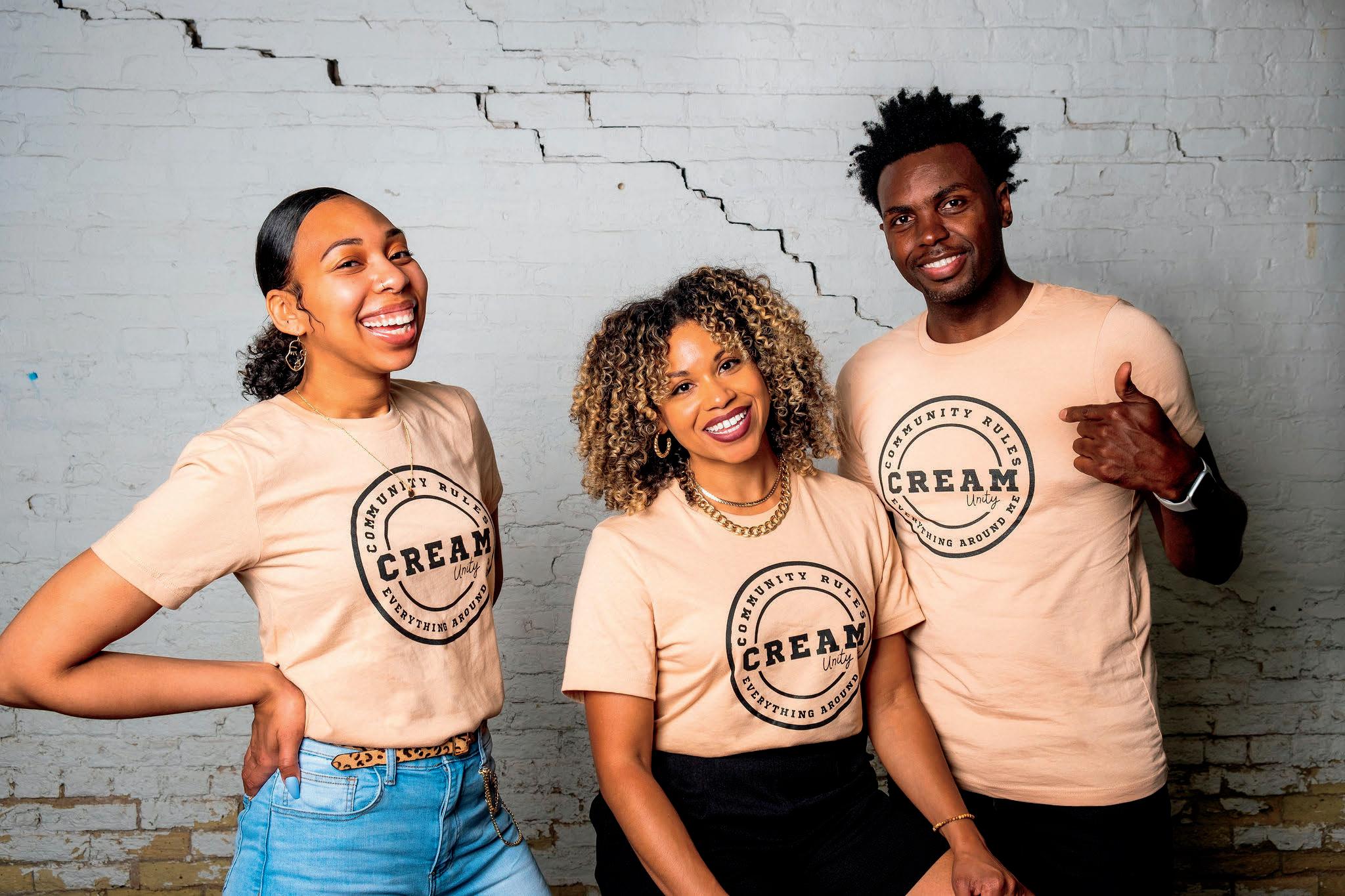
28 MUSIC CREAM Unity allows people to champion that our community is the kinship of ALL its people and neighborhoods. With each purchase a 20% donation is made to a community based non-profit org. COMMUNITY RULES EVERYTHING AROUND ME CREAM E S T D . 2 0 2 2 Unity ADVERTISEMENT
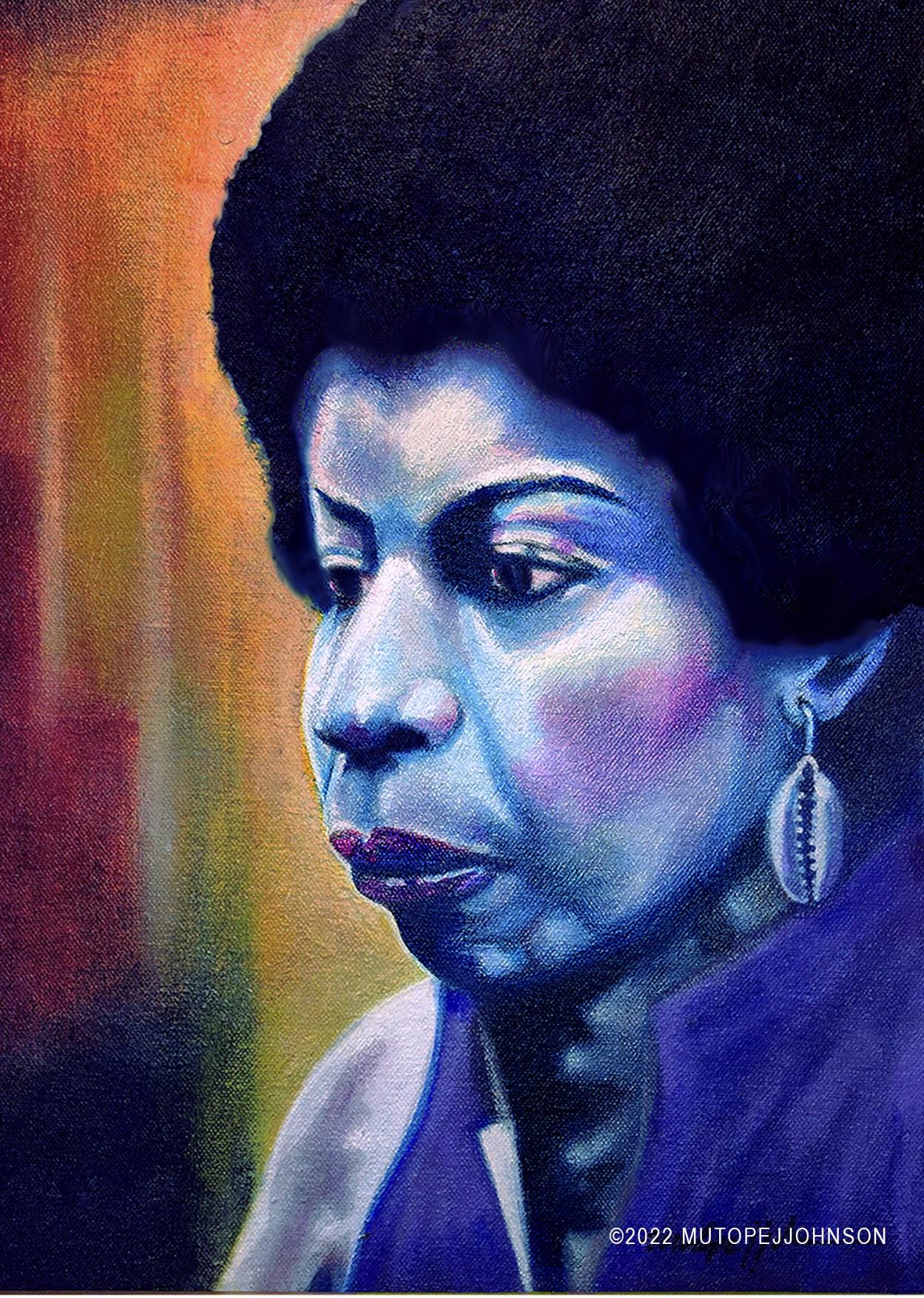
Representation matters.
That phrase is an understatement with a gravitas that has shown its horns time and time again. From the lack thereof to the stereotypical [and strategic] placement of black and brown faces in the media, what we see has become a prophetic example of what we can be. The subtle nuances of cultural imagery that straddle the lines of art and media are territory CopyWrite plays in often, taking unorthodox approaches to an industry that often dismisses our ingenuity. But we are not the first. Our predecessors are absolutely cultural convergers like The Source, Vibe, Word Up, Write On, and the lux of Ebony, Essence, and Jet. However, the real antecedent of this publication is one that comes from closer than you think.
Mutòpe Johnson has lived a life that feels familiar. His journey is a layered manifesto of who he is as a person, a professional, a media maker, a visual artist, and all the other monikers that come with knowing who you are. While he is best known for “themes directly related to celebrating African-American History and Culture”, his work has taken on various forms that grapple with the contemporary norms of the visual world and its link to a larger narrative.

30 MEDIA + FINE ARTS
Mutòpe Johnson
MJ: “When you think about what a creative person is and the professional pursuit that they seek, for me it starts at a very early stage. You have to discover who you are and what you want to do in life. . . I was able to discover that very early. As a young kid growing up in Milwaukee I knew from the very beginning that being a maker and being creative were all I knew. It was just a matter of what creative path I was going to pursue in order to really make it a reality.”
His life starts in the heart of Bronzeville in a house on 4th and Brown st, just adjacent to St. Francis Church. His family had been a victim of the infamous displacement of the thriving community due to eminent domain policies and were forced to move. Luckily they found a home on 7th and Locust that would be the base camp where his creativity would foster.
MJ: “I literally taught myself how to draw and paint. . . I used to walk from 7th and Locust to [7th] and North ave, to go to the library. I would carry as many books as they would give me. I did that until I went through the entire self of ‘How to Draw’, ‘How to Paint’, art, and art history books. I was no more than seven or eight years old.”
However, it wasn’t until high school that he pinpointed how these skills would come into play professionally. His strategy was clear: he would use sports as a catalyst to get into college, using a guaranteed two-year scholarship to run Track & Field for UW-Whitewater. He had been recruited nationally but the reassurance of placement seemed like a better opportunity to actually get a degree. While at
Whitewater Mutòpe would study Fine Arts, earning his BFA.
MJ: “The concentration was on Illustration and Graphic Design. But of course, all the studio classes I had were Painting, Ceramics, Drawing. . . It was a rigorous practice but I was more than convinced that was the way to go. Luckily for me, I was at least versatile enough to move in other directions. So while I was at the university I worked for what was called the University Center Activity Board, which was the booking office where we booked entertainment for the campus. That gave me the chance to work for the advertisement and promotion departments. I also worked during the entertainment as a lighting and stage hand. That kind of put me on the right path.”
The right path indeed. Using several forms of visual language, he dabbled in skills that are useful beyond the “creative spaces” and dug deeper into those fields.
MJ: “As I moved into my career pursuits, it was graphic design intentionally. . .I landed a job with this one magazine
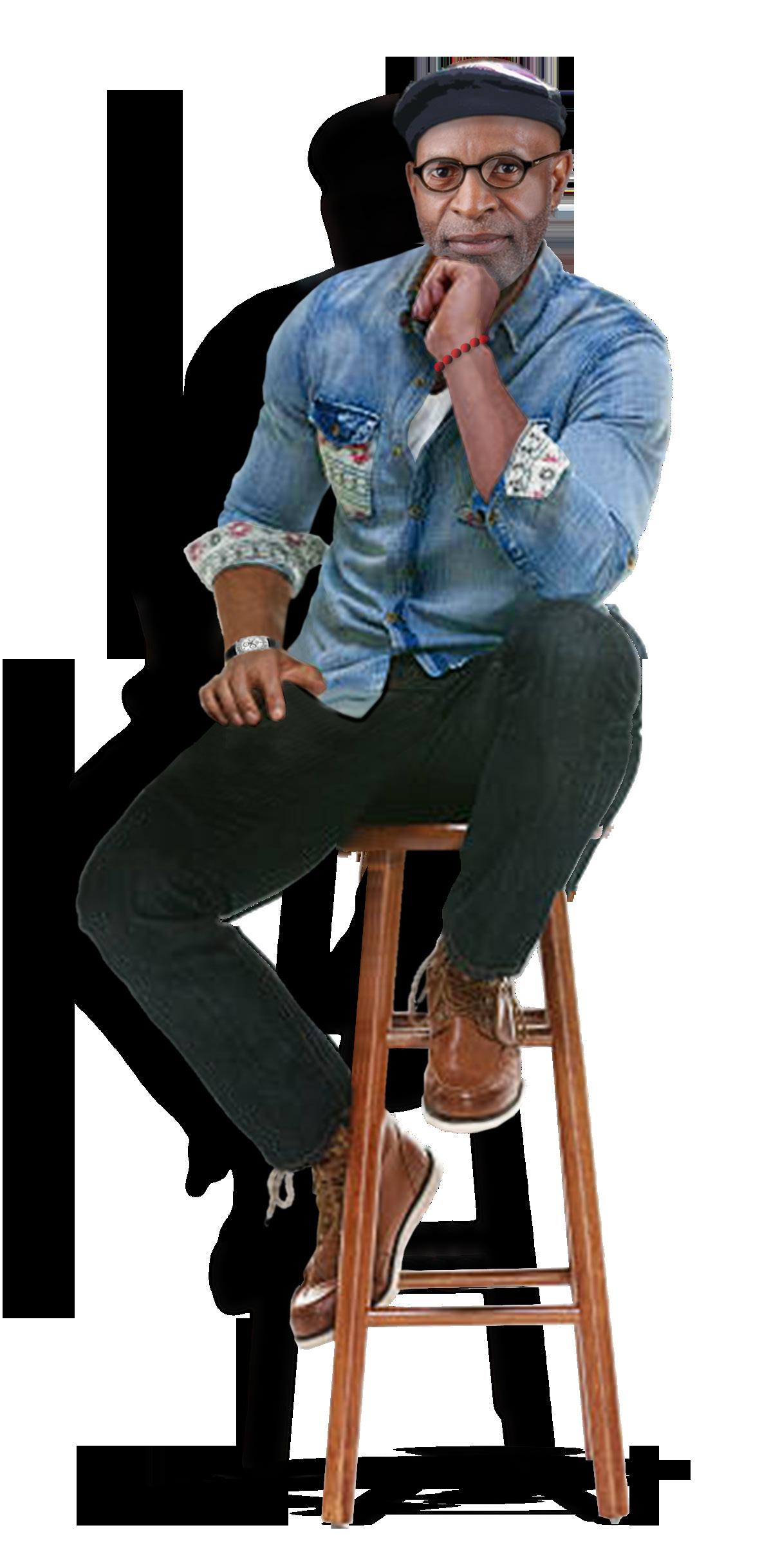
MEDIA + FINE ARTS
company that used to be on Michigan Avenue time, that was the sister company to National Geographic. We did five magazines and that’s when I learned the magazine trade.”

During that time Mutòpe would work on stories and ads while learning the art of distribution and circulation. {You know the stuff that they don’t teach you in school LOL]. From there he would move into the government sector, working for the Milwaukee Country Graphics Department where he used his creative skills to serve all the county departments with visual assets. But after ten years vested into that type of role, he was bored, with no real momentum that he could claim to be his own.
MJ: “All my friends were excelling because they were working in private industry and they were making twice as much money as I was. They had all the latest equipment. I felt I was getting kind of stagnant. So I literally just up and quit.”
Now let’s pause.
Quitting a stable job because you’re “bored” is something that has been frowned upon in African American Culture since the moment we were started to get paid in this economy [Deep eye roll]. The idea of security has been a method to keep us fearful of exploring our talents, creating our own opportunities, taking on new roles, and living our best lives. But Mutòpe is not the first to take that leap, especially as a creative. This brings us to question how creativity and the professional world collide. Thus, who truly benefits from creative labor?
He eventually gave the private sector a run, working in small design studios and eventually landing in a few major advertising agencies. This put him on the path to becoming an art director and ultimately a creative director for one of the largest advertising markets in the midwest. During this time his skills would expand even more, taking on the feats of photo shoots, copywriting, model design, and new industries such as tourism and the medical field. However, Mutòpe had not forgotten about his own creative expression and was simultaneously building a Fine Arts career.
MJ: “It’s one thing to work for private and public entities. The other side of creativity pulled me into the fine arts world, which meant gallery shows [and] exhibitions at museums.”
The parallel pursuits gave Mutòpe the balance that most creatives struggle to maintain. It pulls from every piece of you, consuming your mental capacity, exploiting your artistry, and demanding you to split your attention equally with both being the priority. The drama of it all seems so exhausting, but when done right it becomes a declaration of authenticity that can not be separated. They both need each other to feel complete [or at least that’s what we tell ourselves].
As if that had not been enough, Mutòpe also embarked on a collaborative adventure that combined creative, communal, and business ideologies together producing a multidimensional Milwaukee media legacy.
MJ: “I was all over the place. I teamed up with family
32
members, my brother [Matthew Johnson] being one of them, and we created a television show famously known as Teen Forum. Teen Forum was on for about twelve years or so. We basically created pathways for young people. We taught them journalism, television, [and] radio. You know, how to write, how to produce, how to edit, and how to be a talent on camera. Some of the people who came through our program are pretty notable now. Like Ashanti Hamilton, Milele Coggs, and Ebony Silas. There are a whole bunch of others. . . they became the alumni of Strive Media.”
[Sound familiar? It should! The methodology of teaching younger generations tools that may foster talents beyond the media industry is at the core of what we do at CopyWrite.]
Stride Media Institute also produced Gumbo Magazine and Ya’ Heard Magazine, two publications that centered around Urban culture curated by teens. Gumbo Magazine specifically, was originally an informative tool for parents to know what their kids were doing in this after-school program, helping create creative portfolios and talent reels for students interested in taking their skills to collegiate institutions and the professional world. Strive’s programming actively used mass media to engage youth to develop into business and community leaders, while promoting diversity [says our research]. They also partnered in creating Jam for Peace programming [a wellmissed 414 throwback event] creating major connections with all the other major media outlets in the city.

to use] Milwaukee to seek out “better” opportunities has continued to plight our city, especially within our more disenfranchised communities. If everyone qualified to make real institutional change leaves how can we ever emerge into something worth staying for?
CW: “What was it that gave you the confidence to stay here and become successful?”
MJ: “Here is really the key thing. I love what you are doing at CopyWrite Magazine now. I remember your humble beginnings. So one of the things we set out to do was to change the attitude of Milwaukeeans and creative people here in Milwaukee. That was not just folks who painted or did poetry but performing artists as well. While we were trying to make it a lot of our colleagues like Eric Benét and several other artists who were basically on the come up, right along with us [made us think] ‘Why can’t there be a nightlife or entertainment scene right here in Milwaukee?’. So we would go to other places and see what they were doing in California, or Boston, or Chicago, or in the South. What we do is bring some of that [back] and recreate it here. Because truth be told, we love the water and when you are standing on the shores of McKinley Beach it looks like the ocean. So we thought of it as the third coast.”
Don’t get us started on our under-represented freshwater supply of prime real estate. Tuh! The world has got us all messed up. . . But we let them. We allow them to downplay the resources we have. We continue to feed into the storyline that there is nothing to do here. We keep letting the idea that this is the “worst place for African Americans to live” control how we cultivate our homes and how we steer the next generation. It’s a strategic investment to gentrify our communities, reverse “white flight”, and keep up this perpetual ploy to disarm the strength of our collective voice [Perk up & Peep game].
Little did they know that their efforts in producing a wellequipped talent pool in Milwaukee would allow for these young professionals to be competitive enough to enter the national market scoring jobs in different states, still leaving a void in the community that had nurtured them.
This phenomenon, again, is not a new discovery. The practice of fleeing [yes, fleeing is the word we are going
MJ: “The attraction of staying here was that rather than be a small fish in a big pond, I wanted to at least be a bigger fish in a smaller pond.” And he is.
Milwaukee is the base camp for Mutòpe and all his creative endeavors but that doesn’t mean he is confined to the Milwaukee market. In fact, the lower cost of living here has allowed him to stretch his dollar, which includes
“We did it thinking that what we would do was create an opportunity for young people that we didn’t see and try to literally produce the talent that was missing.”
MEDIA + FINE ARTS
frequent travel and collaboration on a national scale.
MJ: “What was missing was having the links to the kind of lifestyle, in the cultural/entertainment area that was lacking. So we tried to grow our own literally. That was the motivation. We saw some success in doing that. You’d be surprised through the different outlets we had how we were able to connect with people across the country. Some of the biggest names in the business we had a chance to interface with them directly. We learned a lot. The things that we learned not to do were just as important as what to do.”
He told us about his experiences going to the Jack the Rapper convention, where you had to be a part of the music business just to get invited. [Mannnnnn, if only we could go back in time and be there!]. Those events were game changers not just for the talents that we now call legends but also for this Black-owned Milwaukee-based entity. It gave them the ability to connect with record execs, artists of all kinds, and harness the confidence to do so.
CW: “I think it’s amazing because I used to read Gumbo. It’s actually one of the influences that [contributed] to why [CopyWrite] exists as my second calling and became a thing. I could see myself in that magazine.”
MJ: “I’m happy that you said that.”
CW: “It was important that I knew it was from [Milwaukee] as well. I felt the quality of it, even at that age because I was very visually inclined. . . My mother worked for the Milwaukee Public Library so I would go down there and spend time in the teen section and there would be a copy of every issue [of Gumbo]. Eventually, she got me my own subscription. So when I look back on it, it was very influential. And I know other young people who you worked with, who are not so young anymore, that it also influenced and changed the trajectory of their lives. So I know the work that we are doing isn’t new. I always tell our staff that other people have made a way for this to be a reality. No matter if those [outlets] no longer exist or they decided to go on a different path. Somebody planted a seed. . . and you are one of those people. So thank you for that.”
mentorship and guiding young minds. He has just pivoted more of his attention into the Fine Arts side of things.
After receiving his MFA from the UW-Milwaukee, Peck School of the Arts, he taught for seven years in the Art and Design department at UW-Whitewater.
MJ: “That was kind of strange. It was kind of unbelievable intentionally because truth be told, I didn’t plan on being a college professor.”
CW: “You either!?!” [As we said before, Mutòpe’s journey feels oddly familiar LOL]
MJ: [He laughed] “I didn’t plan on doing it but I was just minding my business and then people began to take notice. Especially the alumni . . . Because I was working in both the Marketing and Advertising business and as a Fine Artist. Both of those were two parallel lives with very different ways of looking at professional pursuits. So when you talk about ‘Creative or an Artist, which one are you?’, I say I’m just an artist who happens to be a creative person. . . I ended up doing a seminar there as a guest artist. I had three sessions to give and I didn’t know that I had three and the other guest artist was only doing one.”
When he questioned why he had more sessions than the other guest artist, he was informed that his example of career path was one that many students aspire to have. Thus, there was a large demand from the students to learn more. While he was in the midst of his presentation the dean had secretly sat in on his “performance”. Enthusiastic about what had been seen, he was then offered a job. What was supposed to be a one-year stent became a seven-year term.
CW: “Transitioning from being a student of the game into being a professor, a mentor, a teacher, is there a difference in the thrill of it? Was it consistent because you were doing your own thing on the side, or did you ever feel discouraged at any point?
MJ: “The only time I have ever really been discouraged is when you hit a moment in your career when you are working for other people. When you work for other people they place demands on you. But I have never been in a situation where I was doing something that I didn’t love doing. So I wanted to be in creative space. It didn’t matter what the creative space was. . .The cool part was I didn’t get bored too often, I just got overworked because I had multiple things to do. That’s time management. That time management transferred over to my professional private practice.
Though Strive Media Institute [& the beloved Gumbo Magazine] is no longer active. Mutòpe has not given up on
[There is a longer conversation here about collaborative making, the notoriety of contribution, and the identity of the working creative but you know the vibes.]
34
“You show young people a way then that way they are more assured of themselves as they go forward. That is the beauty of it.”

CW: “Let’s talk more about your Fine Arts practice. You’re a man of color in Milwaukee, in an industry we already know is very small [in this market]. You are now in the space where people know your name, they know your work, and you get to make an influence. You’re an OG in the fine arts world.”
MJ: “That’s what they say!” [He smiled]
CW: “That’s the truth Mutòpe! That is where you are at now. . . What is the reason you think you have become so successful in that side of your career and bypass all the things that make it hard for a person in Milwaukee and a man of color to do something like that?”
MJ: “I think the first thing that kind of comes to mind is that I was never in a hurry to make it. I knew I had to put in the work. I had to be able to intelligently tell my story but produce. . . There is an old saying that says, ‘You continue to work and create until you no longer have to introduce yourself. So that was one of the things I tried to work towards. I knew that with hard work would come the recognition. Hard work does not necessarily mean it is with or without the struggle. Because the struggle for me was always just being in the right place at the right time and knowing what resources were available to me. Being an African American man in Milwaukee, the museum world and the Fine Arts world did not always fully embrace– We’re just now seeing different sorts of national and international recognition coming to a lot of my colleagues and friends across the country.”
And these colleagues and friends are not just the creative lineage that we come from in Milwaukee, but other African American makers in places like Minneapolis, Chicago, and Detroit who were having similar struggles in the post-industrial cities that they were from.
MJ: “We had what they call an artist exchange program. . .That’s how I met a lot of people. We broadened our net a little bit so we weren’t just dependent upon Milwaukee. I don’t think of myself as local and if you talk to a lot of my colleagues we don’t embrace the term local. We are Milwaukee based. From here you can go anywhere you want to. We can jet out. . . So we never limited ourselves to geographical areas. We learned from other artists, what their struggles were and what their successes were. . . We collected each other’s work. We would go [to where they were] and support their efforts. But we were never in a big hurry to make it.”
With all that being said, Mutòpe also mentioned that some of his closest colleagues are his female friends, or as he referred to them his “Homettes”.
MJ: “There are some really strong women here who are artists. They are just now really being discovered and they have been doing this work for years. So OG can be transferred to them as well.”
Women like Evelyn Patricia Terry and Della Wells [Thank you both for your remarkable contributions. We pay homage to you too.] are amongst the names of many African American women who have been creating history through art. He also mentioned Blanche Brown [of Chicago] and Tia Richardson [ featured in Issue 12, Folklores & Festivals of CopyWrite Magazine] as women
who also deserve more recognition and a list of several others.
MJ: “Where exhibitions did not exist, we did them ourselves. We formed collectively an arts organization called ABEA. That simply meant, Artist, Beginning to Educate Americans About African American Art. . . So we did our own shows. We did them at colleges, universities, galleries, museums, So where we were waiting, we didn’t realize the people we had been looking for, they were us!”
This realization resonates with us deeply. The idea of some great hero swooping in to give us a big break will never suffice. Waiting for a solution will never solve the true problem. For change to prosper, creating the change you want to see will always be our advice to those eager to live out their passions. Set your goal, find your squad, cultivate your skills, and go get it!
CW: “We can currently see the legacy building that you and your colleagues are doing right now and it’s also right here in Bronzeville. Can you share with us a little something about that?
The idea of the Bronzeville Center for the Arts [BCA} was born in the pandemic from Facebook postings that Della Wells was doing to really share the accomplishments of African American artists across the country. Through her postings, one of her patrons got wind of what she was doing and wanted to be supportive and offered seed money to start this African American Museum. Linking in the rest of her esteemed colleagues, including Mutòpe, the BCA is now working on two development projects to create the home for its exhibitions, community, engagement, and another culturally attuned programming.
MJ: “We are building an institution that will cater to the Fine Arts, as well as our community. It will focus on visual arts, the African Diaspora, and the African American experience. Through that, we will do workshops, exhibitions, and engage with the community directly. We will share even more lofty pursuits than before, more than any one of us could do alone.”
Mutòpe assures that the idea is not to have just contributions from his generation be the foundation for this institution but to onboard younger generations and their ideas. They are looking at BCA as an opportunity to make a path and not follow one.
CW: “Is there anything that concerns you as we all try to re-claim Bronzeville as this place for arts, culture, and entertainment? We are trying to carry on the history and culture that is already here and because of that historical displacement was hard to maintain. Is there anything about the narrative now or where it is going that you dislike?
36 CONTINUE READING TIA’S INTERVIEW ON THE NEXT PAGE > MEDIA + FINE ARTS
“I feel like I’m still on a quest to try and build a legacy now. . . Legacy is not about what I am currently doing, it’s about what people will say about what I have done.”

MJ: “The only thing that I dislike is the fact that the naysayers think we can’t do it. That is the part that bothers me but at the same time, it motivates me. I have had some of my highest achievements when people told me I could not do something. . . The other thing that bothers me is the wealth gap. But I am also encouraged that if we can control the entertainment factor, which is what we have always done as Black people then holding on to our cultural lineage is our wealth. So the talk on the street right now is that we don’t want our art to be commandeered by others. We hear the word all the time ‘Culturally appropriate’ the things that we have done. . . They are playing our music. They are using our language. I always say, ‘You want to dance and sing my blues but you don’t want to live my blues’. As long as we understand how far we have come and the value of what we have invented, holding on to it will be our wealth. As long as I am alive, I will make sure our story is being told.”
Just as word is bond, at that moment we shared a history lesson. A lesson that spoke on the Great Migration, the evolution of linguistics that have re-titled our people and what we call ourselves numerous of times, the gilded color of skin as the Bronze of Bronzeville, African American journalist and publisher Horace R. Cayton Sr., and so many other exemplars of the “Black” experience.

As always, we asked Mutòpe to leave us all with advice that may help the generations to come and he said:
The only way to do this is together.
/CW

38 MEDIA + FINE ARTS
“Do the research and look for those of us who are still living, breathing, and giving back.”

RR RR
RR
FN FN ADVERTISEMENT
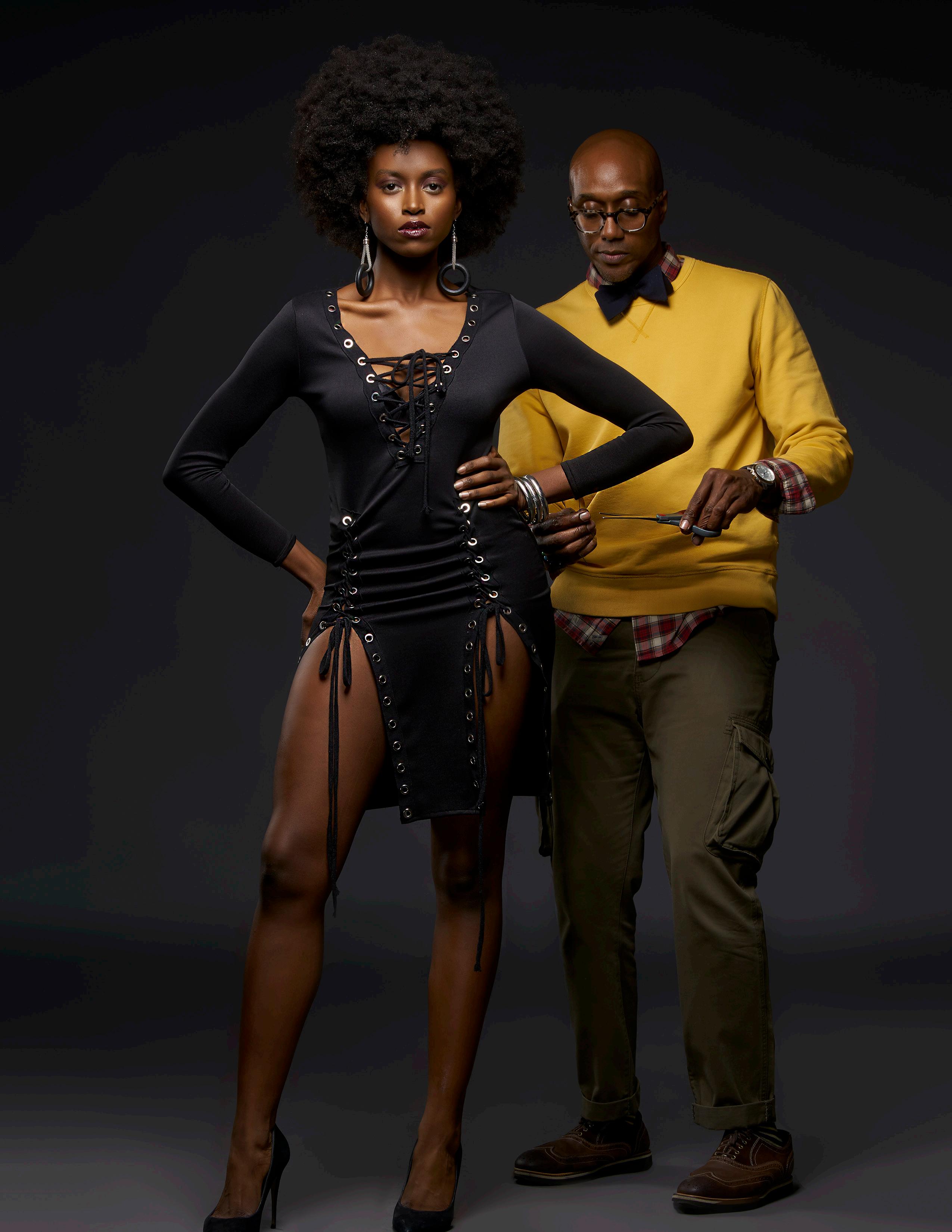

IMAGE + STYLE
You have to understand and believe how a person presents themselves is a reflection of who they are.
Jeff McAlister is someone you see and immediately understands that there is a story behind the looks he serves on the daily. He is a styling icon in our city and a heavy hitter in the personal imaging department. Humbly, he also believes he dresses down which is something we don’t agree with [LOL]. For instance, the day he came for his /CW interview, Jeff wore two casual items (camo shorts and a denim jacket). Two items we see everywhere. But it’s how he coordinated the look that would make people see those items differently. Simple accessories; glasses, rings, a necklace, chain, statement socks and shoes. The ensemble just seemed to fit him so well. It fit his aura that day. You could see a true difference in the grace he gave these “basic” garments.
This is how we know Jeff loves Fashion.
CW: “How did you find out fashion was the industry you wanted to be in?”
JM: “That’s an easy question. So honestly I always start this way when people ask me about that. I have to give all of that to my father. My father was really my base and my gateway to Fashion. My father and all of his brothers and sisters, and you know everybody is always from the south. . . But the McAlisters’ are about that dress. They were all about their appearance and putting on the best and going out and reflecting that ‘We the shit’.
At an early age growing up in Beloit, a small town in Wisconsin, fashion was what he called a “stretch”. So Jeff’s father would take him to Milwaukee [in comparison that’s the big city] to shop.
IMAGE + STYLE
_________________________________________________________________________

JM: “Whenever it was time to do school shopping, find an outfit for Easter or anything special, I would get the trip to Milwaukee. So it was through him. . .the shirts, the ties, the dress shoes and all of that, is the root from where all of that came from for me.”
CW: “:When it comes to fashion do you have a specific style, or something you call it, or is it just based off of how you feel?”
JM: “I would say the base of my brand and my style would probably be like a dapper GQ. At the end of the day that’s what I am most known for even though I dont wear them as much as I used to.”
Though our introduction to Jeff was for his work as a stylist, that was not his introduction into the fashion industry. Jeff actually started off as a model, navigating through the different types of modeling through the years. With social media not existing during that time his origin story is quite different then the models of today.
JM: “It was the very traditional way back then of getting in the right door to the right people. People always used to tell me I should model because I was so tall. A friend of mine saw an ad and said ‘You should go check this out’.”
And so he did.
But just like many other creative eyes, Jeff is not a monolith. He has his hands in other processes that allows him to foster community connections through other mediums including poetry with Open Mic MKE, and on the board of Still Waters Collective, with Dasha Kelly. He also did branding and imaging sessions with the African American Male Initiative (AAMI), with Randee Drew.
JM: “I still always try to find how fashion connects to these things. Fashion of course has its outward appearance but through these opportunities you can say fashion has an inward appearance because it’s tied to how you feel about yourself or how you could feel about yourself. It broadened my FashionSense brand beyond just styling to another level of helping people transform themselves, change their mindsets, or see themselves in a way they haven’t seen themselves before.”
CW: “How do you handle the chaos, the cretics, and the not so pleasant moments of doing what you do?”
[The industry can be shallow, egotistical, and a hot mess if you don’t know how to navigate it just right]
JM: “I have been told that I have the patience of Job [Jobe]. People will tell me, ‘You know what? You’re too nice’. We all have those moments where you are pushed to the end of the envelope but I try to look at each situation individually. Especially when you are dealing with clients, models or whatever the case may be. Sometimes I just have to take a step back, take a breath and say you know what, I try to understand where they are. How can I bring them to where I am ? I try to meet in the middle without it coming off degrading or patronizing to them in some type of way. Because the only way someone is going to be willing to be open is if you meet them where they are.”
So Jeff does not stoop to the negativity but he definitely is not afraid to set the bar high and where there is no choice but to level up the standards. But where are the standards now? Over the past several years we have noticed a surge in Fashion forward consciousness not just in society as a whole but in Milwaukee’s “third coast” wave. We wonder how the growth feels to someone who is vetted in this space making a living off of its need to exist in this type of market.
JM: “I can think back to when I first moved here to Milwaukee. It almost seemed like it was caught up in a time warp. People really just didn’t give fashion much thought. Even with my first time at [MKE] Fashion Week as a model, it still left much to be desired. . . I think now we are at the time of the emergence of something new. I think that’s because there is a new movement with people being in tune with themselves Fashion wise. When they see different people coming out with brands they can identify with, it’s going to transform the community.”
CW: “Lets not forget how I met you. It was at Rosha’s Battle of Salons event and I was the host. I just remember how I saw sooooo much going on behind the scenes and I knew that you didn’t play around, right before you hit the stage I went up to you and asked are you ready to be announced you gave me this look and I knew immediately let me
“I think now we are at the time of the emergence of something new.”
give him some more time LOL. [It reminded me how I am when it came to clothing and showcases]. I just remember how seamless you made the frustration look.”
Anybody who is serious about their craft knows the process can be just as important as the outcome. Jeff explains that his process does not start with the clothes but actually with the vision. Really focusing on what type of story he wants to tell is what makes everything else fall into place. However, if he is working with a client it’s about building a profile [Cough cough, that is what we call research!] to figure out what the client really needs and how he can use his skills to help.
for classic looks to mix modern garments with personal steez.
CW: Obviously this issue is about homage. How does it make you feel to be included in something like this?
JM: “As I said earlier I am very humbled by it. It’s humbling to be recognized by your peers. This is a passion in itself. I love doing it and its not something I’m doing just for the sake of doing it. Every time you look up there is somebody who is saying they are a stylist. I think they are doing it often just because somebody told them they could dress nice but they really don’t know anything about it. I take offense to that because where, why, how, are they doing this? So to me this is saying that ‘we value what you do’. Also, because this was not something I was seeking, its just a really good feeling.
CW: “Who is Jeff McAlister without fashion?”
JM: “Woahhhh!” [The room halted. Because as straightforward as the question may be it is one that requires true reflection of self, beyond the performative attire and transitioning aesthetic.]
“I would have to say a ship without a sail. It has literally been a part of my life as long as I can remember, even before I knew I was going to be good at it. So to not have it I would be lost.”
Whew Jeff! You hit that on a nail.
To understand. To have something soooo embedded into who you are; without it would be numbing. If we were created for a purpose and to truly live in your purpose, it would be disheartening to live without it.
Though there are many fashion trends that come and go, Jeff is not afraid to keep his foundation authentic to himself while pushing his brand to new ranges with the “New Urban” aesthetic that allows
Understanding that fashion is a part of a bigger spectrum [ You know Culture, Big “C”] we had to ask Jeff about what he thinks that means on a global level. With black Culture topping the charts in most creative industries over the last decade we wondered what Jeff thoughts were on this socially impacting pivot.
JM: “I think from a global perspective it is now evolving to where it is supposed to be. When you think of [the African Diaspora aka Black people] as the originators of the earth, we have already created everything that is here. It is just that as time moves on more people are realizing that. They may not always publicly acknowledge it and just go and do it without saying anything. But we can see it everyday that people are just really embracing our fashion, and our influence in all genres. I think people are just now waking up and realizing that we really drive these industries.”
CW: “That being said, does it bother you? Does it bother you when people are just snatching what has authentically been a part of our everyday existence?”
JM: “It does. It bothers me because if you’re going to use something, acknowledge it. Don’t
44
“To me it’s [all about] the clients because that is the real touch with somebody that needs you, that needs the services, and that’s the real proof of the work that you can do and who you are . . . That is the validation and the purpose of me in this.”
“It’s humbling to be recognized by your peers. This is a passion in itself.”
IMAGE + STYLE


just take it. But when you’re used to just taking things that privilege kicks in. . . and we as a people are sometimes too forgiving and just look the other way, a little too much at times. We should be a little more like, ‘Aye, now you know where that came from’.”
[It’s the dreads, cornrows, big hoops, du rags, surgically modified big lips, and kente cloth on people who are not of a melanated ethnic background for us. . . But we won’t hold you on that tangent lol] Jeff has made it far in his career but there are a few other things that he would like to cross off of his bucket list of accomplishments including, doing New York or LA fashion Week [& not like just there on an adjacent fashion project but the real deal publized big brand type thing]. Let’s put it in the atmosphere. If any stylist can make it happen it would be Jeff! /CW: “When you go somewhere and see people do you ever style them in your head?”
JM: “Yes, all the time. It’s a habit of the job. I can just look at a person and say to myself, ‘I could do a lot with you’. Then there are other times when I’m like, ‘I need to pull out my fashion citations’.”
[Like cutting the strings off the back of your blazer or, changing out run down tips on your heels. Citation! Citation! Citatiooooooon! Lol]
But even that’s a habit that comes with years of experience and a value that sometimes can be hard to measure. When it comes to the pay rate for the service Jeff provides “The prices have definitely gone up”. But knowing where to put your skill, time, and talent on a rate sheet is something even he has struggled with. He notes that styling is more than just showing up with clothes to place on a person. There are so many other factors and laboring task that go behind it that more of us should value. [We as a collective have to do better when it comes to paying our creatives what they are worth].
CW: “In this industry I know it can be very hard for us. I always say this is a place where opportunities are not being given. We have to create them on our own. I think I relate to you with that because we have definitely created paths of our own right here in Milwaukee. What would you say to the young Jeff McCalisters in the world that maybe you would have wanted or needed to hear?
JM: “I would honestly tell them to take some type
of business course. Then you will be able to lay out everything accordingly like getting your LLC, getting a trademark, sending invoices, drafting contracts, knowing how to deal with vendors and different designers. Taking a course or something that can give you that is vital. The creative side is already there if you have the passion. It’s the business side that creates those bumps in the road for me.”
It’s sound wisdom that all creatives really should heed. The more serious you are about your craft the more the business must be on point.
When asked if he had any final words to share, Jeff took this moment to say something that resonates with us so deep that we won’t follow it up with a witty ending. We wont clarify what he meant or even try to offer an additional interpretation because it is perfect. ABSOLUTELY AND POSITIVELY, PERFECT.
JM: “What I would really like to see in this community is that we start to work together as a single community. Not as separate communities that exist in a community, if that makes sense. We know everybody is at different levels but I think where we are weakest at right now is that we are operating in [silos]. We would be much more powerful and much more successful if we operated as one.”
We really wanted to highlight a pillar that inspires the industry of Fashion in Milwaukee, let alone myself seeing another black man in this industry. It allows me to know one day my time will come and anyone looking in this direction that may look like us will know its possible. Jeff is living in a time where all eyes are on you, but here he is looking out for us.
WE THANK YOU FOR BEING UNAPOLOGETICALLY YOU, SO THAT WE MAY BE UNAPOLOGETICALLY US.
/ Vato for CW
MEDIA + FINE ARTS
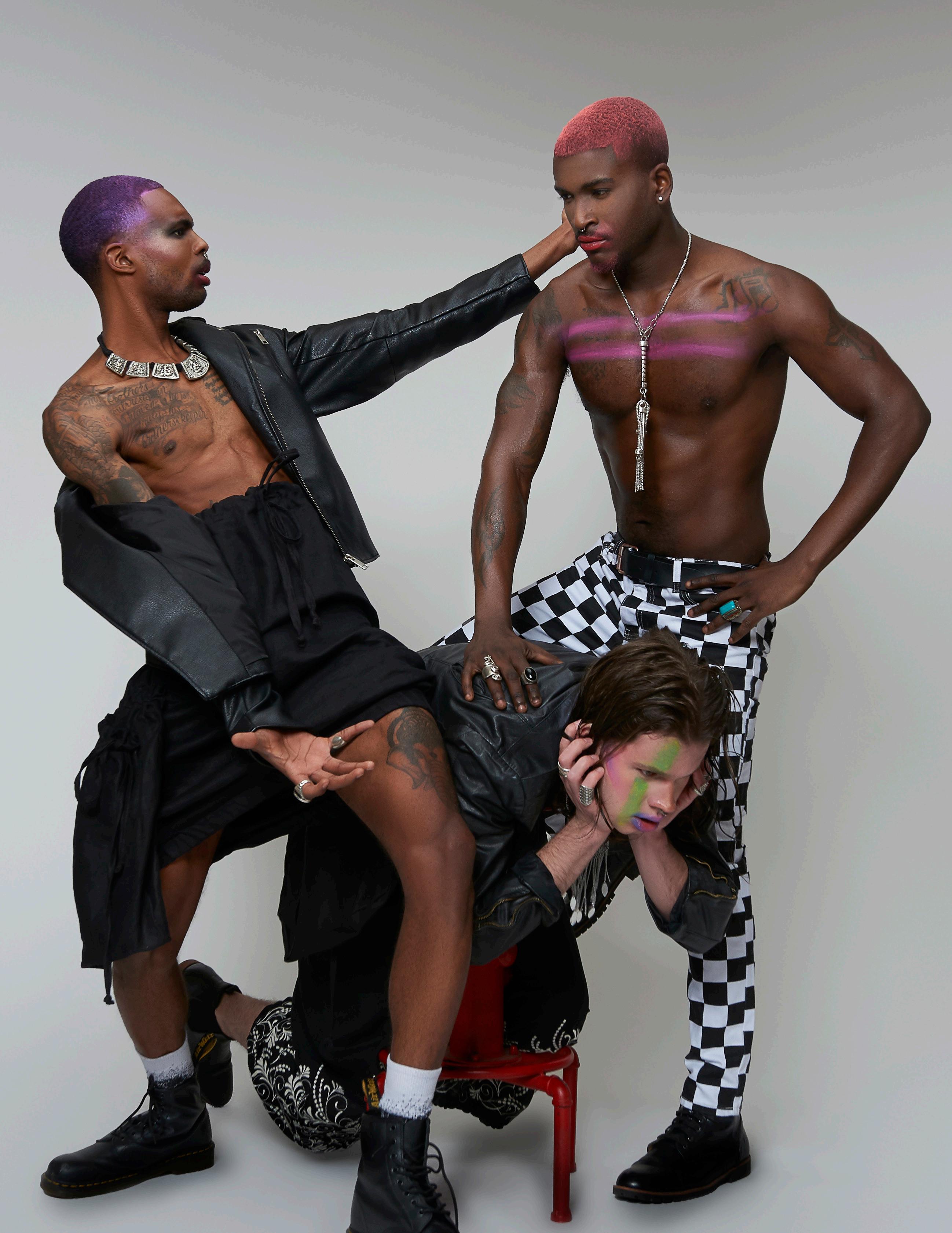
PASS THE BATON, THIS IS BIGGER
Let’s get right into it . . . y’all are weird.
I’ve found myself saying that more than usual lately. Mainly because of the people I’ve encountered and the mentalities they have. I’ve realized, when you are taking the road less traveled, you are the one paving the way, so a lot comes with the territory. Especially in a city with less resources. However, I feel like once you’ve paved the way, you need to pay it forward.
I don’t usually speak out about the things I see going on in the entertainment, creative, and media scene, but with issue 20 being about paying homage and giving respect to those who have come before us, [and yes, we 100% need to give them their flowers], I think it’s important to also touch on the fact that there are people who do not deserve to be on that type of pedestal.
I’m so frustrated with some of the men who are the gatekeepers in this industry. They hold too much power and don’t use it for good. They’ll say you have to pay them money for opportunities that should be free, they’ll make inappropriate comments to you, and think it’s okay. And if you rub them the wrong way, if it’s up to them, they’ll make sure you don’t get ahead.
It’s disgusting.
Sometimes I’m frustrated with my peers. I consider myself an independent broadcast journalist. Even though I work for different media companies, I create my own work outside of that. And because I didn’t go the traditional route of working at a big news station, sometimes I feel outcasted. I feel like my work isn’t respected. I feel like some of my peers have become institutionalized and think their work holds more weight than mine just because of the platform they’re on. Even though I did things my way, it gives nobody the right to belittle what I do, because there’s nothing little about it. Like, we can’t coincide together?
That’s crazy. I’m frustrated with people who have “made it,” but don’t help the next person who shoes they once were in. I’m not talking about giving hand-outs, because everyone has to put in their own work. But if you know you could help someone get an opportunity, or you could share some knowledge that you know now and wish you would’ve known back then, do it. That’s how the community as a whole gets better. There are so many examples of how you can pay it forward. If you see someone grinding trying to make it on their own, remember that feeling and lend them a hand if you can. I promise you it’s free.
There are a plethora of more examples I could give, but the bottom line is – we have to do better.
OP-ED
THAN YOU
A lot of us want to make sure we’re leaving a great legacy behind, but in the words of the late great Kobe Bryant, “The most important thing is to try and inspire people so that they can be great in whatever they want to do.”
If we all collectively came together more often to help each other out, we would be so much further. We have to be the ones to put our city on, just look at Chicago, Detroit, Atlanta, etc. They rep the hell out of where they’re from and work together to make sure everyone knows it. However, we have a bunch of people here who don’t share the resources out of fear the next person will pass them up, or they’re afraid to lose the title. That’s why when young Black girls ask me how they can do what I’m doing, I make sure to point them in the right direction and share the knowledge I have, because I always wished I had someone to do that for me. Especially in such a male-dominated field.
We’ve got a lot of people who are led by their egos, who are selfish and greedy. Humble yourself. All of this is bigger than you. In reality, we need to work as a team and see that we’re not bigger than one another. To build a legacy that’s going to last forever, we have to bring each other up.
Think about it like a relay race: It’s not about how long you can hold on to the baton, it’s about how we can work together to successfully pass it on, so you can go even

how you’re helping the next generation who wants to do what you do? How many people do you inspire? How do you contribute to making Milwaukee greater?
Of course there are people who do that work [many are featured in this magazine]: they pay it forward every chance they get, they collaborate, they do all the things, and I love to see it! But. . . I know we can do more.
& it starts with not being weird lol
/Carrie for CW
50
making fashion sense
We pay homage to collaboration.
The way it makes anything you can imagine come to life. The way it demands you lead, listen, and learn from something that is bigger than just you.
Bringing different people in a space to highlight their strongest skills.
It is the process of making fashion sense. With the expertise of Jeffery McAlister, we bring you this fashion lexicon of editorial greatness.
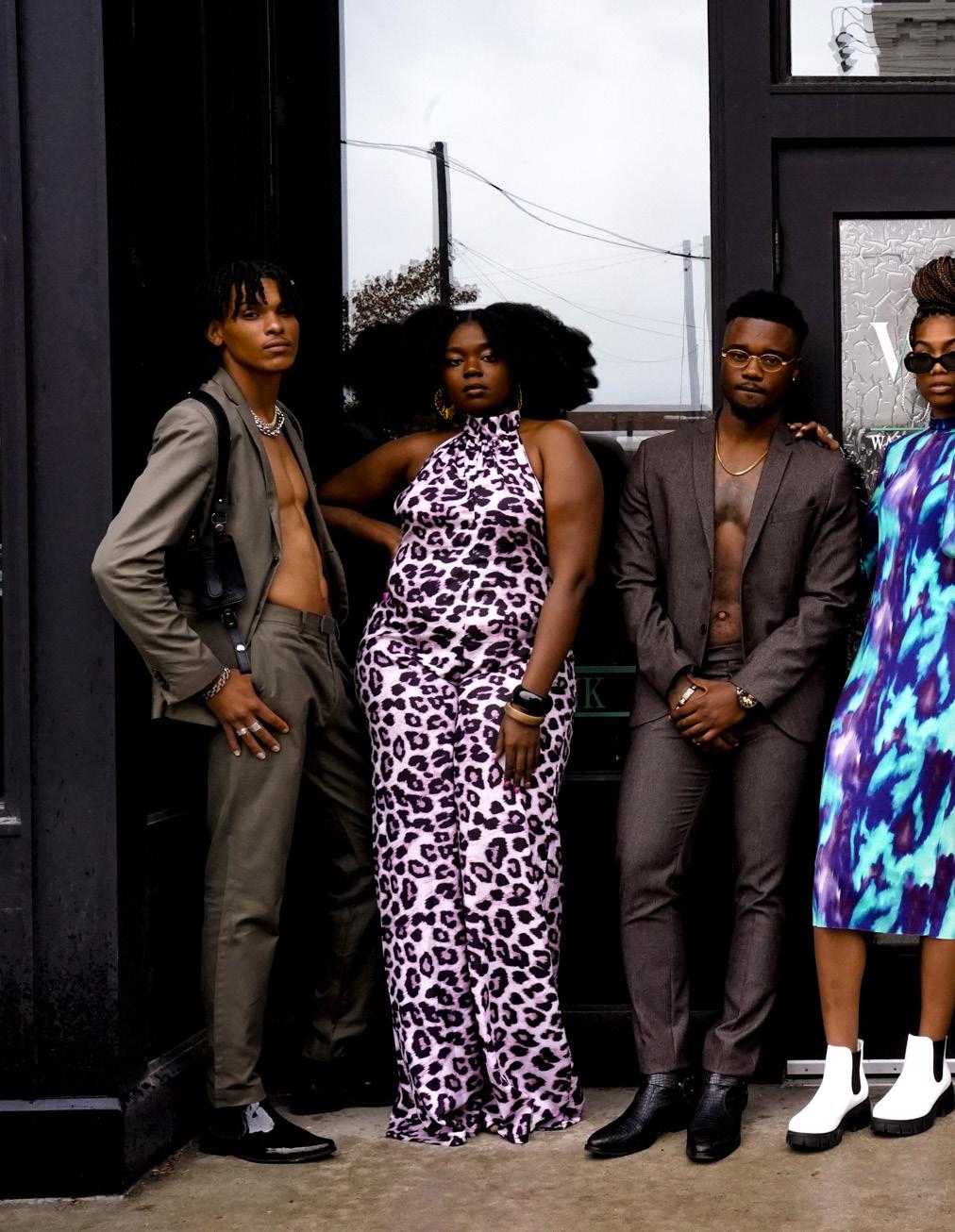
In collaboration w/ Jeffrey McAlister
markpatrickworld] Creative Director
Fashion Editor, Rakim
Fashion
Deborah
of GG Collections, Marc Patrick
Creative Director,
Wall Street
of
Sense,
Render [@deborahrender]
[@
+ Model Coach, Vato Vergara [@vatovergara] Curator +
Kyndal J [@kyndal_j]
Wil [@w.il.ra] Photographer, Charese Gardner, Owner of The
Stock Bar [@wallstreetstockbar].

sense


@psychmand @st.apollo_ @iam_deionharris

@lanena_latina


@emire_sewell @jezzriahb

@pop_that_pooley



@_skylarice_





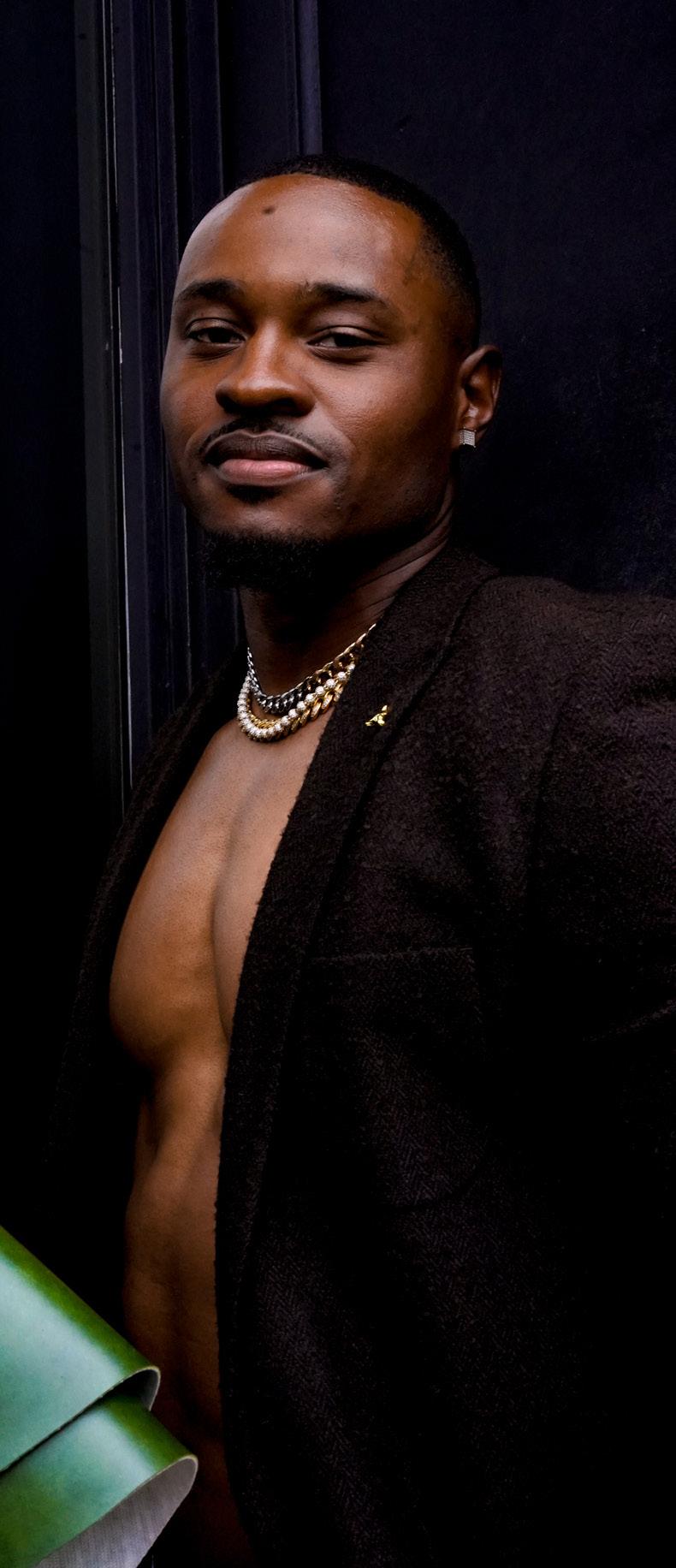

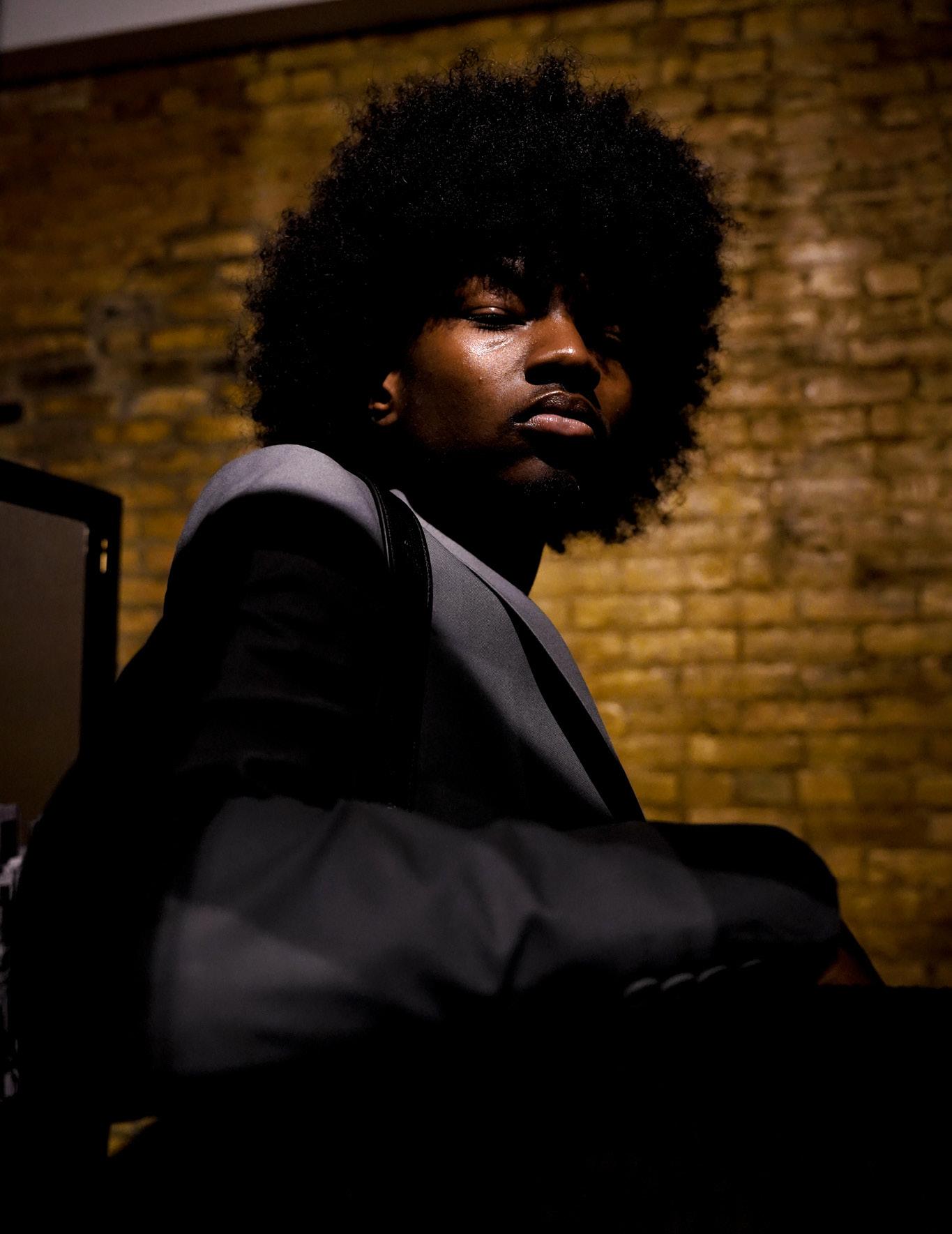

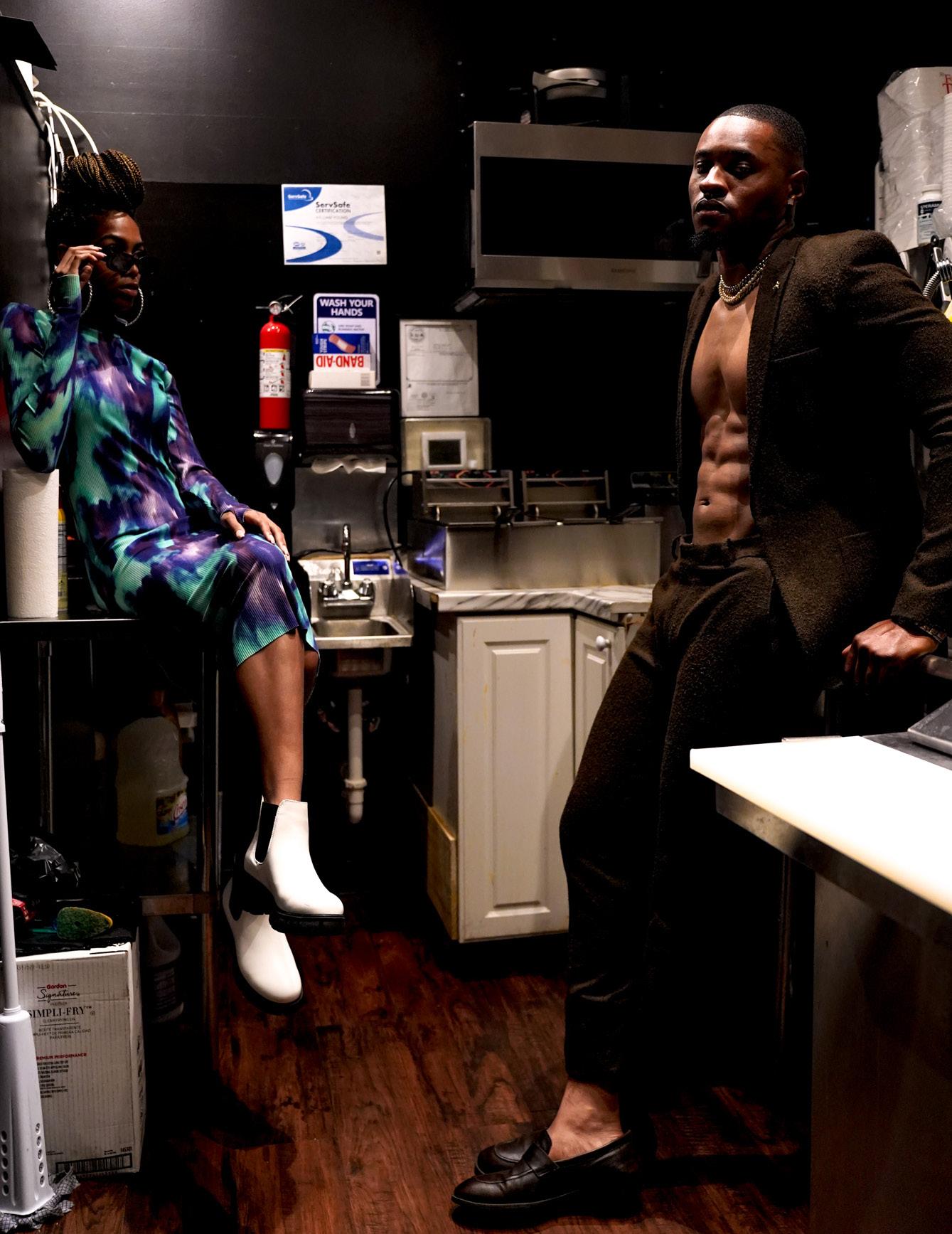



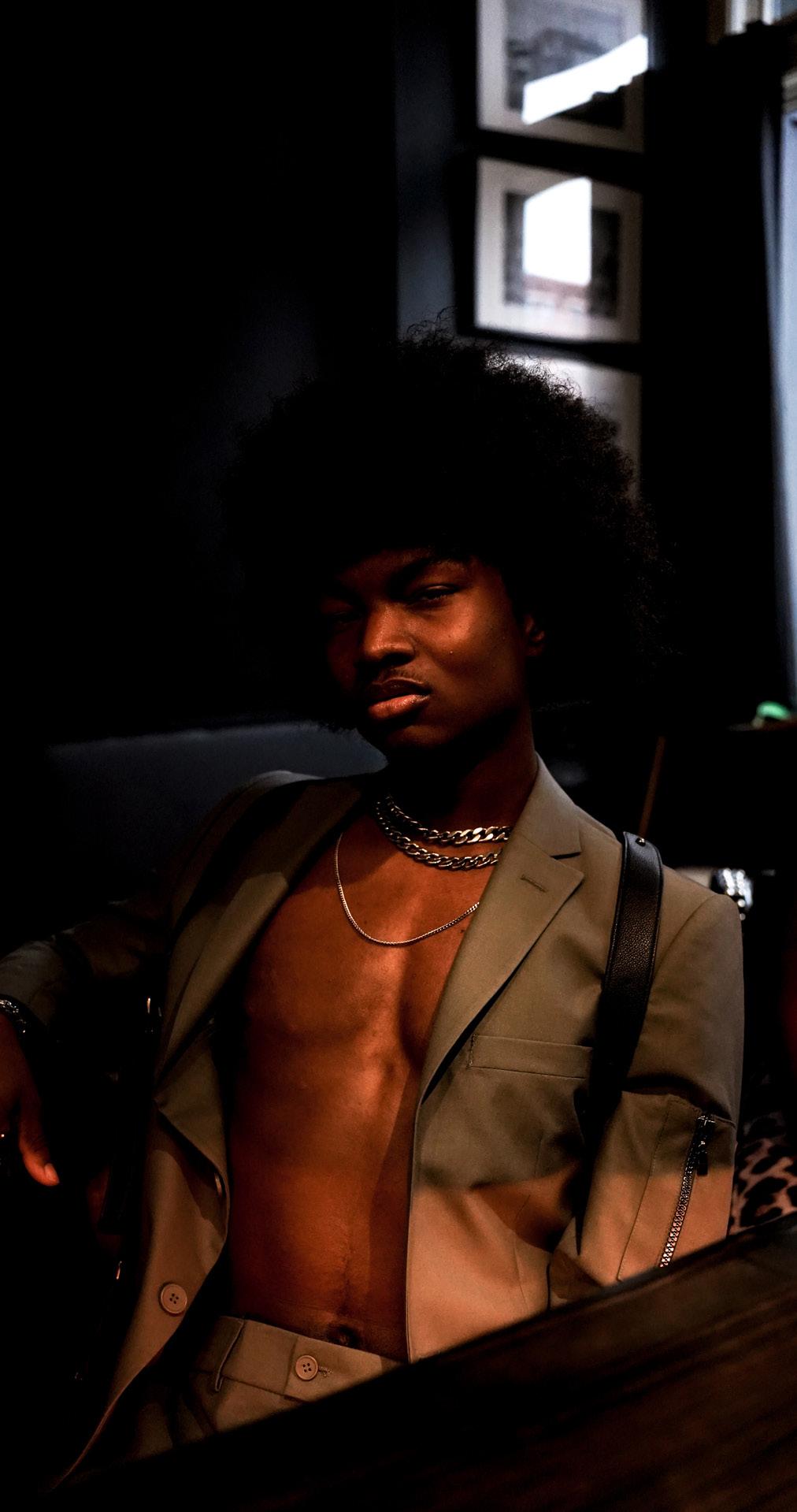
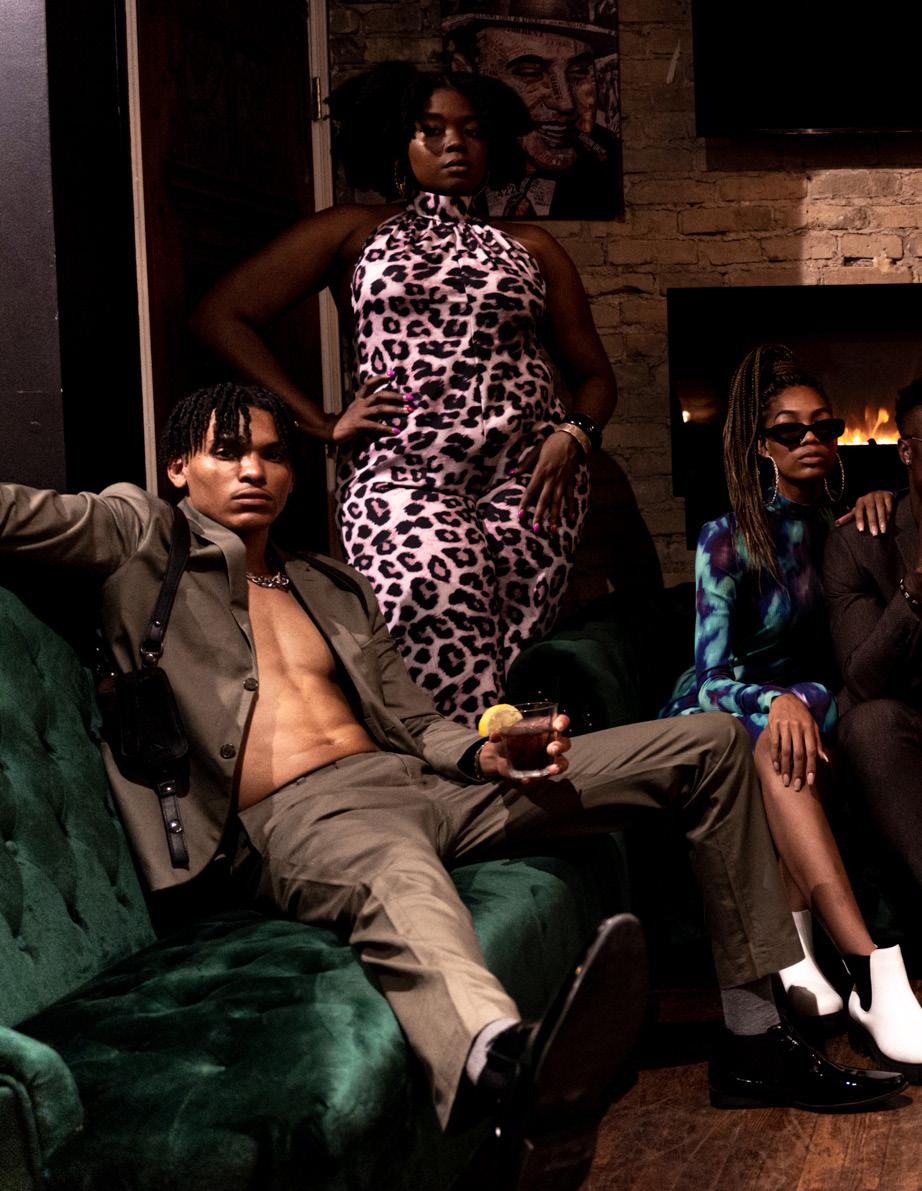

H e a l t h w e a l t Yh o u r i s H e a l t h w e a l t Yh o u r i s Y o u r i s
Y o u r c r e a t i v i t y s h o u l d n e v e r c o m e a t t h e c o s t o f y o u r h e a l t h . G e t a h e a l t h i n s u r a n c e T h a t f i t s y o u r b u d g e t and follow your dreams. f r e e h e l p t o f i n d a p l a n i s a v a i l a b l e o n h e a l t h y m k e . c o m .

ADVERTISEMENT












































 greens & the small machines
greens & the small machines















































